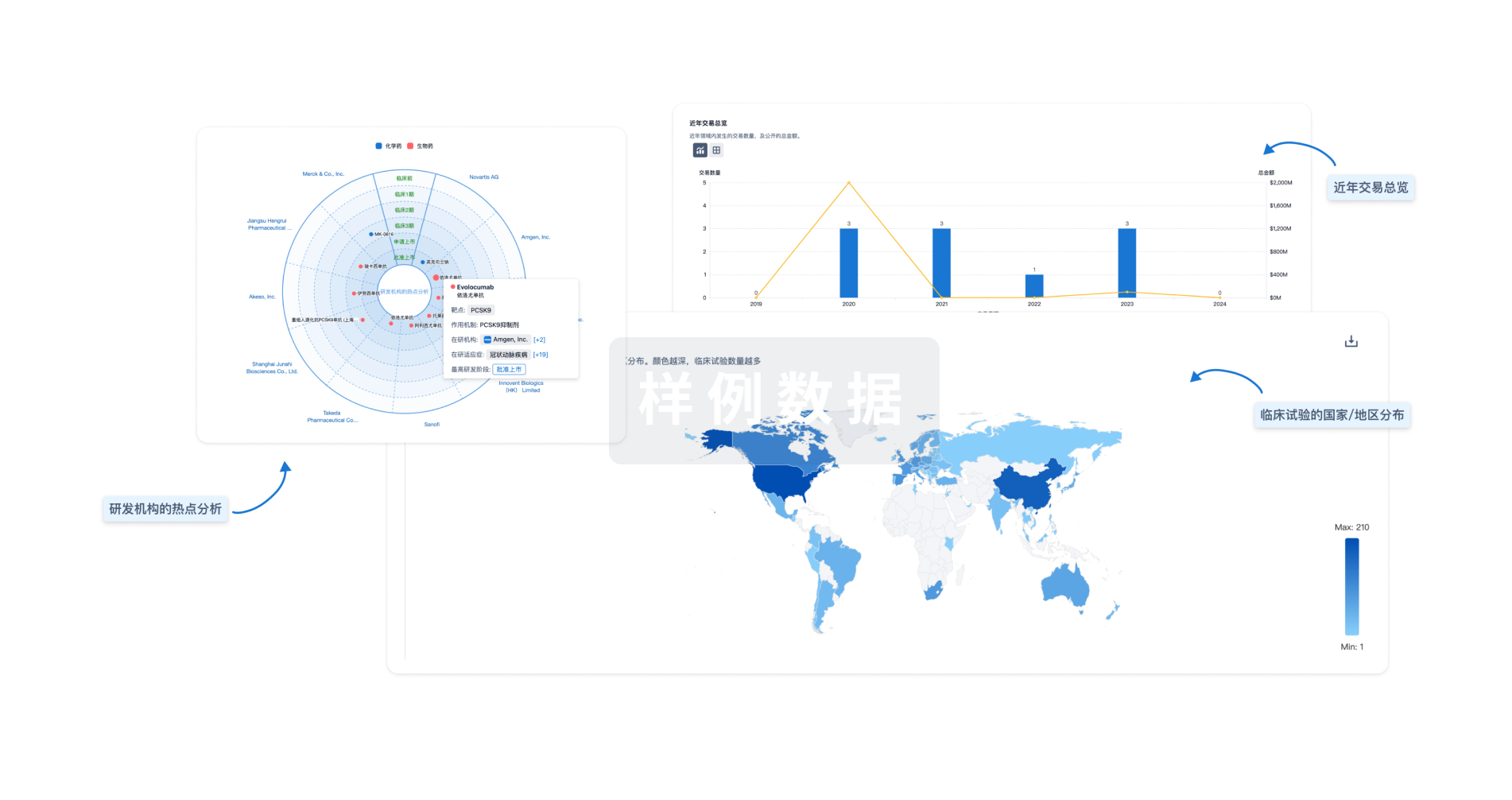预约演示
更新于:2025-05-07
HDACs x ER
更新于:2025-05-07
关联
2
项与 HDACs x ER 相关的药物作用机制 ESR1降解剂 [+1] |
在研机构 |
原研机构 |
在研适应症 |
非在研适应症- |
最高研发阶段临床前 |
首次获批国家/地区- |
首次获批日期1800-01-20 |
作用机制 ERs拮抗剂 [+1] |
在研机构- |
在研适应症- |
非在研适应症 |
最高研发阶段无进展 |
首次获批国家/地区- |
首次获批日期1800-01-20 |
100 项与 HDACs x ER 相关的临床结果
登录后查看更多信息
100 项与 HDACs x ER 相关的转化医学
登录后查看更多信息
0 项与 HDACs x ER 相关的专利(医药)
登录后查看更多信息
754
项与 HDACs x ER 相关的文献(医药)2025-06-01·Environmental Pollution
Multi-mechanistic effects of bisphenol A on testicular dysfunction and endocrine disruption in adult male Labeo bata: oxidative stress, inflammation, and dysregulated energy sensors
Article
作者: Mukherjee, Urmi ; Ghosh, Soumyajyoti ; Maitra, Sudipta
2025-06-01·Archives of Microbiology
Genome-wide identification and expression analysis of epigenetic regulator gene families in the medicinal mushroom Ganoderma lucidum
Article
作者: Sossah, Frederick Leo ; Swallah, Mohammed Sharif ; Bashir, Mona Alrasheed ; Fetisoa, Monia Ravelonandrasana ; Huang, Qing ; Bondzie-Quaye, Precious
2025-04-01·Domestic Animal Endocrinology
17β-estradiol inhibits lipopolysaccharide-induced inflammation and pyroptosis of Leydig cells of the domestic yak (Bos grunniens) via the SIRT1/Nox4/ROS pathway
Article
作者: Wang, Jin'e ; Chen, Zhou ; Yang, Yahua ; Ma, Junyuan ; He, Wen ; He, Lin ; Yang, Yanmei ; Huo, Shengdong ; Hu, Songming ; Niu, Xiaoying ; Li, Yang ; Zhaxi, Yingpai ; Yang, Chongfa
42
项与 HDACs x ER 相关的新闻(医药)2025-04-20
DRUGAI疾病发生和进展的特异性研究中,识别调控转录因子(TRs)仍具有挑战性,这些因子通过调控元件和表观基因组信号控制基因表达。大规模多组学表观基因组数据的引入,为解析调控元件及其调控因子的复杂模式提供了可能。研究人员在此提出TRAPT,一个多模态深度学习框架,可通过学习和整合靶基因的顺式调控元件及全基因组结合位点的调控潜能,推断转录因子的活性。在570个与TR相关的数据集上,TRAPT在预测转录因子,尤其是协同因子和染色质调控因子方面优于现有方法。此外,该方法成功识别出与疾病、遗传变异、细胞命运决策及组织相关的关键转录因子,展现了基于表观组数据识别TRs的全新视角。基因表达调控由多种上游转录调控因子(TRs)共同驱动,包括转录因子(TFs)、协同因子(TcoFs)和染色质调控因子(CRs),它们介导启动子与远端增强子的信号传递。异常的基因表达常与疾病发生密切相关,因此识别关键调控因子对于理解疾病机制至关重要。随着 ChIP-seq 和 ATAC-seq 等技术的发展,顺式与反式调控图谱得以清晰描绘。TRs 在染色质开放性和组蛋白修饰等表观信息的共同作用下,展现出细胞特异性的调控活性。此外,大量研究表明 TFs 可通过结合启动子或增强子等顺式调控序列,调节靶基因表达。鉴于基因调控机制的复杂性,研究人员亟需利用大规模表观基因组数据,全面捕捉基因上游的协同调控特征,以提升 TRs 的预测能力。高通量测序技术的快速发展使 ATAC-seq、DNase-seq 和 ChIP-seq 等数据迅速积累。然而,不同来源的数据存在噪声干扰、批次效应及冗余等问题,增加了整合与表示学习的难度。目前已有多种方法尝试通过功能基因集推断上游 TRs,如 Enrichr、ChEA3、Lisa 等,但这些方法大多基于统计富集分析,未能充分利用顺式调控元件(CREs)的详细信息。而CREs是 TF 功能的核心,缺乏这部分信息将限制调控因子的准确预测。一些方法虽引入 CRE 数据,但仅局限于与输入基因集相关的区域,无法覆盖全基因组调控图谱。此外,TRs 往往倾向于结合在活跃染色质区域,表现出结合偏好(TRBP),这类偏好尚未被现有方法充分建模。更重要的是,当前大多数方法仅限于通过基因集推断上游调控因子,缺乏对其全基因组结合位点的推理能力,因此急需能够全面整合CRE与结合位点的预测框架。多组学表观数据的整合也存在诸多挑战,例如跨模态干扰与非线性关系。现有方法多基于传统回归模型,未能有效处理跨模态间的复杂关系。深度学习技术在多个生物学任务中已展现出强大表现,其关键在于高质量数据的采集与建模。研究人员此前构建了多个表观调控数据库,如 TcoFBase、CRdb、TFTG、SEdb 和 ATACdb,系统汇聚了大量 TRs、增强子与染色质开放性信息,构建了当前最全面的表观特征资源库。结合这些数据资源与先进深度学习方法,为深入解析表观调控网络提供了前所未有的可能。本研究中,研究人员提出了一个数据驱动的深度学习框架——TRAPT,融合多阶段学习结构,通过知识蒸馏和图卷积神经网络整合表观特征,联合建模靶基因的顺式调控元件信号与全基因组结合位点,优化 TR 活性表示,并识别上下文特异的关键调控因子。在570个 TR 敲除数据集上进行评估,TRAPT 在预测 TFs、TcoFs 和 CRs 方面均优于现有方法。进一步,TRAPT 成功识别出阿尔茨海默病中的关键因子(如 REST),并在细胞发育与组织数据中准确预测了控制细胞命运与组织特异性的调控因子。结果TRAPT 方法概述TRAPT 是一个整合多组学信息的预测框架,旨在根据输入的感兴趣基因集推断转录调控因子(TRs)的活性。简而言之,该模型以基因集为输入,输出每个TR的活性评分。TRAPT 采用多阶段融合策略,分别处理来自全基因组结合位点的下游调控潜能(D-RP)以及源自顺式调控元件的上游调控潜能(U-RP),从而解决TR结合偏好(TRBP)和顺式调控信息缺失(ICCP)的问题。TRAPT 的流程主要包括四个步骤:计算表观调控潜能(Epi-RP)与转录因子调控潜能(TR-RP):研究人员收集了超过 20,000 份表观基因组数据,包括 ATAC-seq、H3K27ac 和 TR ChIP-seq 数据,并进行预处理后,计算每个基因的调控潜能。通过对表观组数据统一加权衰减,并对TRs采用上下文特异的衰减策略,分别得到 Epi-RP 和 TR-RP,用于后续建模。预测 TR 的下游调控潜能(D-RP):该步骤旨在将 Epi-RP 与 TR-RP 融合,构建 TR 与表观样本之间的异构网络(ERN)。研究人员采用 k 近邻算法建立网络,并使用条件变分自编码器(CVAE)与图变分自编码器(VGAE)构建的知识蒸馏模型(D-RP模型)进行优化。教师模型学习多模态嵌入,学生模型学习统一、低噪声表示。该机制提升了模型对跨模态数据的鲁棒性,输出为 D-RP 矩阵。预测查询基因集的上游调控潜能(U-RP):研究人员设计了另一个知识蒸馏模型(U-RP模型),以Epi-RP和输入基因集为基础,选出关键的表观组样本并推断其调控作用。学生模型在教师模型提供的“软标签”指导下,通过稀疏组套索(SGL)方法引入组内与组间稀疏性,实现对非冗余、非线性组合样本的精准筛选。输出为U-RP向量,包含与查询基因相关的染色质开放性(ATAC)与活性状态(H3K27ac)信息。整合 D-RP 和 U-RP 推断 TR 活性:将归一化后的 TR-RP 和 D-RP 矩阵逐元素相加,再与 U-RP 向量逐元素相乘,获得整合调控潜能(I-RP)。随后,使用 ROC 曲线下面积(AUC)衡量 TR 与基因集的相关性,并合并两种路径得到最终的 TR 活性评分。综上,TRAPT 融合了 TR 的全基因组结合潜能与靶基因顺式调控潜能,能够在上下文特异的基础上,高效识别调控输入基因集的关键 TRs。TRAPT 在基准数据集上表现优越研究人员采用“目标TR排序分数”作为主要评估指标,衡量算法根据基因集预测对应调控因子排名的能力。例如,在 GATA6 敲除实验中,若GATA6本身的排名靠前,则说明预测性能较好。为全面评估TRAPT,研究人员整合了来自 KnockTF 数据库的570个转录因子敲除/敲低数据集,经过质量控制和差异表达分析,从每个RNA-seq数据集中筛选出上调与下调基因,作为TRAPT的输入,并对预测结果中的目标TR排名进行评估。研究人员将 TRAPT 与多个主流方法进行了比较,包括以基因集为输入的 Lisa、BART、i-cisTarget 及富集分析方法 ChEA3。评估标准包括命中前10或前N个目标TR的数量,以及整体TR识别表现。结果显示,TRAPT 在识别前10个TR方面比表现第二好的方法(Lisa)高出13%;相较 i-cisTarget 的提升更超过200%。TRAPT 的 AUC 达到 0.643,明显优于其他方法;其平均倒数排名(MRR)为 0.067,也分别比 Lisa 和 BART 提高了18% 和 76%。这些结果表明 TRAPT 在预测 TR 活性方面具备显著优势。不同于以往方法主要集中在 TF 的预测,TRAPT 引入高质量的转录协同因子(TcoFs)与染色质调控因子(CRs)数据,使得其具备更全面的调控因子预测能力。在 TF、TcoF 与 CR 三类子集中,TRAPT 均展现出领先性能。特别是在 TcoF 与 CR 的预测中,Lisa 的表现显著下降,而 TRAPT 仍保持优异结果,说明其在多类调控因子预测上的全面性得益于多阶段融合策略与丰富的数据支持。为了验证 TRAPT 的优势并非仅因数据覆盖度更高,研究人员将 Lisa 和 BART 与 TRAPT 一同使用 Cistrome 数据库的背景数据,并以 KnockTF 数据集为标准重新评估。结果显示,即便在相同背景数据下,TRAPT 的整体表现仍优于 Lisa(提升 30%)和 BART(提升 85.7%)。进一步评估显示,TRAPT 在 TF、CR 与 TcoF 三个类别中的AUC均高于对比方法,其中对 CR 的预测性能甚至比 Lisa 高出 198.4%。此外,研究人员还比较了不同蛋白家族在不同类型数据(如 TR 敲除数据 vs. TR 结合数据)下的预测表现,发现部分家族(如 CP2、RXR-like)在敲除数据上表现更佳,而其他家族(如 zf-C2H2、IRF、THR-like)在结合数据中效果更好。这可能源于转录因子敲除后引发的二级转录调控效应。最后,针对大规模数据整合可能带来的运算时间问题,研究人员比较了 TRAPT 与 Lisa、BART 的运行时间。结果显示,TRAPT 不仅性能优越,还具有更快的运行效率,尤其在单个TR活性预测任务中显著快于其他方法。多阶段融合策略显著提升转录调控因子预测性能为验证多阶段融合策略对 TR 预测的提升效果,研究人员进行了系统的消融实验。TRAPT 中的 U-RP 模型用于模拟靶基因顺式调控元件的调控潜能,捕捉其上下文特异性的表观状态。当移除该模块时,整体性能显著下降,说明其有效表征了输入基因的表观调控特征。D-RP 模型则预测TR在不同条件下对基因组的结合偏好,考虑了调控元件的活性。去除该模块同样导致性能下降,进一步表明结合元件活性对于TR功能建模具有重要意义。此外,研究人员还通过计算TR与远端增强子结合比例,构建了特异性调控潜能模型。去除该TR特异性建模也导致性能下降,显示其对识别不同调控模式具有重要作用。TRAPT 融合多种表观组学特征以预测最终的TR活性。对不同模块性能的深入分析发现,TRAPT-H3K27ac 模型对上调基因集预测更优,而TRAPT-ATAC 模型则更适合下调基因集。当移除所有表观模块,仅保留启动子区域模型时,预测性能显著下降。进一步逐步移除表观模块,整体性能也持续下降,表明TRAPT在多模态特征融合方面具有良好稳定性。知识蒸馏机制在TRAPT中也发挥了重要作用。相比未使用知识蒸馏的模型(NKD),使用蒸馏策略(KD)在 KnockTF 数据集上提升了5.4%,在 Lisa 数据集上提升了7.9%。在top-10 TR预测任务中,KD模型的AUC高出8个百分点,表现显著优于NKD。模型在训练与验证集上的损失值快速下降,且蒸馏策略下 D-RP 学生模型收敛更快、准确率更高,表明知识蒸馏提升了模型稳定性且未引入过拟合。在 D-RP 模型中,研究人员利用 kNN 算法构建TR与表观组学样本之间的连接网络,并以连接恢复任务评估其预测能力。实验结果显示,在验证集中,教师与学生网络的损失值迅速下降,最终在测试集上分别达到 auROC 0.81 与 auPRC 0.84 的表现。即便在最多屏蔽15%边的情况下,模型恢复能力依然稳定,AP 值保持在0.8以上,表明其对缺失连接具有良好的鲁棒性。U-RP 模型的目标是基于基因集与 Epi-RP 矩阵预测顺式调控图谱。训练过程中,其损失值也稳定下降。为解决冗余样本筛选问题,研究人员分析了在不同数量样本下的性能变化。当特征数达到10时,性能提升趋于平稳,与已有研究一致。最后,研究人员比较了TRAPT在预测上调与下调基因集时的表现,发现其对下调基因集的预测更为准确。这一现象也支持了激活因子多于抑制因子的生物学观察。多数 TR 仅具有单一功能,部分如 CTCF、NANOG、FOXA1、ESR1 则同时具有激活与抑制作用。综上,TRAPT 能够准确识别激活型、抑制型及双功能调控因子。TRAPT 在 ESR1 敲低实验中准确识别关键转录调控因子ESR1 是乳腺癌 ER 阳性亚型中的关键转录因子,调控多种与疾病风险相关的下游基因表达。为验证 TRAPT 在疾病背景下识别关键 TRs 的能力,研究人员将其应用于 MCF7 ER+ 乳腺癌细胞中 siRNA 敲低 ESR1 后得到的差异表达基因集。TRAPT 准确预测到 ESR1 在下调基因集中排名第1,上调基因集中排名第17,反映出其在乳腺癌中兼具激活与抑制功能。TRAPT 还识别出与 ESR1 密切相关的多个转录因子、协同因子与染色质调控因子,包括 FOXA1、EP300 和 MED1。其中,GATA3 是哺乳腺细胞命运的重要调控因子,FOXA1 通过调节染色质可及性影响乳腺癌发生发展,EP300 可乙酰化 ESR1,增强其靶基因表达。此外,从 STRING 数据库得到的这些高排名 TRs 之间具有频繁的相互作用;TCGA 和 GTEx 数据的共表达分析也显示 GATA3、FOXA1 和 ESR1 三者之间具有显著相关性,进一步验证了 TRAPT 的准确性。研究人员还分析了 D-RP 分数对 TR 活性的刻画能力。将 ESR1 及其相关 TR 的 D-RP 分数分别作用于目标基因与背景基因集,结果显示其在目标基因集中显著更高(如 ESR1 在 ATAC 和 H3K27ac 模块下的 p 值分别为 3.3e-38 和 8.6e-34)。随着预测排名下降,TR 的重要性逐渐减弱,而排名最末的 HDGF 表现出明显较低的调控潜能,说明 D-RP 能有效区分关键 TR 与非关键 TR。此外,研究人员构建了高低 I-RP 分数的 TR 活性曲线,发现高分组的 TRs 对基因集的信号更强,进一步支持 TRAPT 的预测准确性。考虑到 ESR1 可结合远端增强子(如 ERSE),TRAPT 利用其专属的调控潜能模型对远端调控进行建模。研究人员将增强子分为近端与远端两类,发现预测出的 TR 更倾向于在目标基因附近的增强子区域中结合,而非背景区域。GATA3 和 FOXA1 明显偏好近端区域,ESR1 与 EP300 则未表现出显著偏好。最后,研究人员可视化了 ESR1、GATA3、FOXA1、EP300 和 HDGF 附近的差异表达基因轨迹,发现前四者在目标区域均表现出明显的结合峰,而 HDGF 则缺乏这种特征。这一系列结果进一步验证了 TRAPT 在预测 TF、协同因子及染色质调控因子方面的可靠性和解释力。预测阿尔茨海默病相关的关键调控因子转录因子(TF)结合位点上的遗传变异可能改变其结合能力,进而影响基因表达和细胞功能。为验证 TRAPT 在疾病研究中的适用性,研究人员将其应用于阿尔茨海默病(AD)GWAS 后分析。研究人员利用 MAGMA 工具从 GWAS 汇总数据中获得 AD 相关基因集作为 TRAPT 的输入,并结合细致的精细定位与结合位点共定位分析,识别出一系列被致病变异影响的关键 TRs。在欧洲人群 GWAS 数据的基础上,TRAPT 所预测的前 25 个 TRs 中,有 68.2% 的结合 SNP 来自 AD 因果变异(p = 2.5e-12),而排名后 25 个 TR 的比例显著更低,表明排名越高的 TR 越可能与 AD 密切相关。进一步分析发现,TRAPT 排名前列的 TRs(如 SPI1、RELA、REST)在致病变异上的结合强度高于背景变异。例如,SPI1 与 71 个致病变异发生交集,远高于背景(p = 3.6e-4)。GSEA 统计检验也证实前列 TRs 与因果位点显著富集。通过 FINEMAP 打分和功能注释,研究人员发现 rs10119 为评分最高的 AD 相关变异,与 APOE、TOMM40 和 APOC1 等关键基因相邻,且被多个预测的 TR 所结合(如 REST)。rs10119 位于染色质环结构的关键节点,多个已知 AD 相关的 TR(SPI1、STAT1、HDAC2 等)都在其上下游区域结合,进一步强化了其功能重要性。此外,在 AD 相关的 H3K27ac ChIP-seq 数据中,TRAPT 所选样本的调控区域与 rs10119 高度重叠,说明模型即便不依赖 AD 特异的表观数据,也能选择出具有相似信号的替代样本。识别驱动细胞命运和组织特异性的关键调控因子转录调控因子在细胞命运决定、分化过程和组织特性维持中起关键作用。研究人员进一步将 TRAPT 应用于单细胞转录组数据,以识别血液细胞分化路径中的驱动因子。在人类造血干细胞 scRNA-seq 数据中,TRAPT 成功识别了 42 个潜在关键 TR,其中 29 个已知与造血发育密切相关,10 个在不同分化亚群中呈现显著差异表达。此外,部分 TRs 出现在多个谱系中(如 EP300、SMAD1、SPI1、TAL1),另一些如 STAT4 和 TCF4 则特异性分布于 NK 和 pDC 谱系,具有已知的调控功能。在另一个人类胚胎干细胞数据集中,TRAPT 同样成功识别出 GATA3、TFAP2A、GATA2 等在滋养层细胞中活性增强的 TRs,以及 GATA6、SMAD2 和 EOMES 等在内胚层细胞中活跃的 TRs,这些结果均与既往研究一致。对 GTEx 项目中30种正常人组织的 RNA-seq 数据分析中,TRAPT 利用每个组织的差异表达基因成功预测出特异性调控因子。例如,心脏组织中识别出 MED1、TBX5、GATA4;前列腺中识别出 AR、FOXA1、HOXB13;而乳腺与脂肪组织共享了 PPARG 和 CEBPA。在对预测结果进行层次聚类时,乳腺与脂肪组织、女性生殖系统相关组织(如子宫、卵巢、宫颈)因细胞组成相似而聚类在一起,进一步验证了模型的生物学合理性。讨论转录调控因子(TRs)在调控基因表达、维持细胞稳态和引导发育过程中起着核心作用。TR 介导的转录程序通常具有独特的表观基因组图谱,并在细胞状态变化与疾病发生中充当“开关”。然而,当前针对特定基因集(如差异表达基因、单细胞标记基因)准确预测其上游TR仍面临挑战,主要受限于缺乏覆盖多样细胞类型的TR表观数据。为解决这一问题,研究人员提出了深度学习框架 TRAPT,通过双阶段知识蒸馏提取调控元件的活性表示,整合超过 20,000 个大规模表观基因组样本与全面的TR背景知识库,精准预测上下文依赖的关键TR。在570个TR敲除/敲低数据集上,TRAPT 相较 Lisa、BART、i-cisTarget、ChEA3 等主流方法表现出显著性能提升,成功识别出与疾病、遗传变异、细胞命运与组织特异性密切相关的核心TRs。当前TR预测方法主要分为两类:一类是基于基因集富集分析的方法,如 Enrichr、TFEA.ChIP、ChEA3 和 MAGIC,依赖统计检验评估TR的重要性,但无法模拟TR与顺式元件的真实结合;另一类如 i-cisTarget、BART 和 Lisa,通过模拟TR结合预测活性,但未能充分考虑TR的结合偏好。而 TRAPT 则提出第三种路径,融合基因集的顺式调控特征与 TR 的全基因组结合潜能,通过多阶段融合策略显著提升预测性能。TRAPT 的优势包括:融合式策略解决信息覆盖不全与结合偏好问题:多阶段建模同时考虑上下游调控潜能,填补以往方法中顺式图谱覆盖不全与TR结合偏好未建模的空白;双阶段知识蒸馏增强模型鲁棒性:在 D-RP 阶段引入图变分自编码器(VGAE)与条件变分自编码器(CVAE)作为教师网络,缓解分布不一致问题;在 U-RP 阶段,蒸馏引导学生网络选取最优表观样本,提高数据整合能力;图模型优化全基因组调控潜能预测:尤其适用于样本量有限的数据集,补全表观调控网络中的缺失连接,提高泛化能力。消融实验表明,去除 D-RP、U-RP 或蒸馏机制均显著降低模型性能,验证这些模块的关键作用。同时,在连接预测任务中,D-RP 模型在多种掩码比例下表现稳定,展示出对缺失扰动的鲁棒性。应用层面,TRAPT 成功识别了 ESR1 敲除实验中的 ESR1 及其相关的协同因子 EP300、FOXA1;在阿尔茨海默病研究中,TRAPT 能捕捉到如 SPI1、RELA、REST 等高可信TR与GWAS致病位点(如 rs10119)的共定位;在人类造血干细胞、胚胎干细胞及 GTEx 组织样本中,准确预测出与细胞命运(如 GATA3、STAT4、TCF4)和组织特异性(如 MED1、GATA4、AR)相关的关键TRs。所有结果均从多个角度验证了 TRAPT 在多类任务中的稳定性与通用性。值得注意的是,尽管 TRAPT 整合了 17,227 个TR、1,329 份 ATAC-seq 与 1,465 份 H3K27ac 数据,但部分 TR 仍缺乏对应的表观样本,可能影响模型精度。同时,不同 TR 之间的协同或拮抗机制(如转录因子与协同因子之间的相互作用、染色质调控因子的辅助调控)在目前版本中尚未完全建模。未来可引入基因调控网络与因果推理策略,更系统地模拟调控层级间的复杂交互。整理 | WJM 参考资料Zhang, G., Song, C., Yin, M. et al. TRAPT: a multi-stage fused deep learning framework for predicting transcriptional regulators based on large-scale epigenomic data. Nat Commun 16, 3611 (2025). https://doi.org/10.1038/s41467-025-58921-0
2025-04-18
·医药速览
DOI: 10.1021/acs.chemrev.4c00284DNA编码文库(DEL)技术通过亲和力筛选、和深度测序,对庞大的编码小分子文库进行平行筛选,产生丰富的数据集。优秀的文库设计与合成,严谨的筛选逻辑和严格的筛选操作,足够的测序深度和准确性,对于成功发现DEL Hit都至关重要。然而,更好的解析DEL筛选后数据往往是成功的"成功的临门一脚"。随着计算科学的发展,DEL与计算科学的结合似乎找到了完美的应用场景:DEL有提供丰富平行数据的能力,为训练模型提供数据,并可完成验证闭环;计算科学有庞大的运算能力,可以抽丝剥茧,为DEL产生的大量数据集提供内在的关联。然而,事情并没有那么简单而理想。近期,Chemical Review刊载了一篇综述,系统地分析了DEL数据的模式、影响数据的各种因素,并提供了提高DEL驱动的Hit发现的准确性和有效性的方法和计算工具。01基于DEL的Hit发现DNA编码文库(DEL)筛选技术将小分子连接到可读取的DNA条形码上,模拟展示技术固有的“表型”与“基因型”的联系,为“化学型”与“基因型”建立起对应关系,可以快速生成庞大的化学文库,并针对生物大分子进行亲和力筛选和随后的DNA序列解析,以及对应化学结构的鉴定与确认。传统的DEL筛选及随后的Hit验证、优化已经形成了规范式的操作,为各种类型的靶标发现了极具潜力的苗头化合物,并已经成功推动多个DEL Hit进入到了临床试验阶段(见文末往期分享)。当前,随着计算科学的发展,“碰撞”到DEL筛选产生的与生物大分子相互作用的大量结构信息,两者相互吸引,正在另一条Hit发现道路上彼此成就。然而,建立两者之间的联系,不可忽视DEL数据本身固有的局限性。只有深入理解DEL数据的特征,才能真正地架起DEL筛选与计算科学之间的桥梁,充分发挥两项技术结合更大的潜力。在DEL技术的各个阶段建立稳健、标准化的方法至关重要:包括从设计编码方案,到分子砌块的挑选和反应验证,再到Hit的诠释。进一步推进DEL平台从筛选所产生的数据中获得更多的收益。02DEL数据执行模式2.1、离散Hit发现DEL的概念最初受到噬菌体展示及相关技术的启发,因子,DEL Hit最广泛的识别方法也类似于噬菌体展示,经过多周期的筛选产生富集分子,然后合成它们,再进行验证评估。早期的DEL研究模拟生物淘选,通过寻找将PCR扩增筛选后编码的序列信息翻译成化学结构的方法,使在筛选步骤后文库扩增成为可能。二代测序技术(NGS)的出现及其对DEL研究的适应,极大地满足了DEL筛选后数据解析的需求,并进一步使提高DEL文库规模大小更有意义。DEL筛选产生的分子根据其富集程度高于阈值进行分类,然后从其中选择最具潜力的部分进行测试验证。这些分子可以通过off-DNA或DNA偶联物进行合成,通过一些生物物理的方法进行验证,如荧光各向异性、表面等离子共振、ELISA-型分析、微热泳、质谱等。通过这些方法鉴定出的Hit,再结合分子特性进行挑选,供后续药化团队进一步进行先导化合物优化。2.2、序列富集与结构关系测序能力的不断进步,使得可观察到的DEL Hits的数量,远远超过了可以通过试验测试的通量。因此,需要结合算法对DEL Hits进行分类,以最大限度地确定最佳候选分子的可能性,同时最小化挑选的工作量。DEL数据本身就可以指导DEL Hit挑选的决策。如,DNA序列计数、和富集化学结构片段相似模式。定量读取每个分子的序列计数的形式,以及Hits之间的结构相似模式,可以增强对挑选出的潜在DEL Hits的准确率的信心。DEL筛选背后的逻辑是:相比于低亲和力的分子,靶标富集高亲和力的分子。因此,从大量富集的分子中挑选时,可能会优先考虑具有高序列计数的分子。然而,序列计数是否真正反映了结合效力还是个模糊的问题。基于简单的平衡结合原理,在一定范围内,富集度和靶标亲和力之间存在相关性,但仍有许多因素会使这种关系复杂化,如,编码分子与显示分子之间的明显差异等(与酶连接DNA片段的效率和化学连接小分子片段的效率差异有关)。研究表明,当仔细控制以消除噪声源时,序列计数与亲和力之间存在相关性;有研究通过在文库中掺入明确的弱结合物和强结合物,它们的富集程度不同;基于此,可以通过序列计数指导某些靶标亲和力配体发现。然而,这种相关性在较大的文库中通常不存在,原因很多,有合成过程的问题,也有测序深度的问题。然而,序列计数也不应该被完全忽视。有些研究也表明,如在AS-MS实验中,DEL的富集和回收率之间存在适度的相关性;也有研究表明,有些阔多个靶标的DEL的高富集分子比低富集分子更有可能具有活性。执行不同严格程度的筛选可以减少某些噪声源,这可以提高富集数据的可靠性。DEL Hit通常存在化学相关化合物簇,并且这种结构富集模式可以用于定位,显示出某些一致性药效特征模式,为靶标相关配体的SAR提供丰富的信息。此外,当从不同的Hit系列,以及不同的文库中,观察到结构相似性模式,可以增加数据的可靠性,为观察到的Hit的真实性提供信心。这种DEL的独到之处可以指导先导化合物的优化开发,帮助了解的哪些部分具有可变性,或者是结构保守的,为集中精力提供努力的方向。然而,也不可过度解读结构-富集之间的关系。就像序列富集作为定量参数一样,也有其它的因素可以影响特定类型的Hits结构。过度依赖显性特征而忽视单元素集和形似模式不明显的化合物,可能会导致过早地丢弃潜在有价值的化学型。2.3、通过比较筛选获得更深入的见解DEL筛选在几个方面表现出色:它的速度,几周时间即可完成;它的吞吐量,限制它的不是量有多少,而是能测多少(测序深度);它成本效益,仅需要几个到十几个微摩尔的蛋白靶标就可完成一次筛选,并且可平行多条件筛选。因此,可通过设置多个筛选,通过比较不同条件下的筛选结果,获得更加具有逻辑的信息。如,通过DEL筛选对不同物种的血清蛋白进行平行筛选,获得明显不同的筛选指纹,从而能够识别选择性结合物和混杂的泛结合物。而通过竞争性比较DEL筛选,已成为预测DEL靶向选择性和评估耐药性突变敏感性的常规操作。此外,通过设置竞争性结合物的控制筛选条件进行筛选,可以获得有关DEL Hit结合位点的宝贵信息。需要注意的是,在解释比较DEL筛选结果时需要特别谨慎,仅从发表的偏倚性结果,可能会导致使用这种方法的普遍性时产生误判。如就作者Franzini团队的经验来看,DEL结果往往高估Hit的特异性(即on-DNA结果和off-DNA结果的不统一性)。这其中影响的因素有很多,比如DEL Linker的因素影响等,后面会逐一讨论。2.4、DEL数据的化学信息学处理一切开始于NGS测序生成的序列输出文件。这个文件包含序列本身和各自的序列计数(序列被放大的次数,即丰度),此外还有一些数据质量相关的得分。而这些文件也映射到了编码链上的构建砌块标识符。其中序列计数用于计算序列富集和相对于基线(即控制试验)的规范化。这些值可以根据合成库的循环数绘制出对应于每个构建砌块(BBs)的2D、3D散点图。其中每个点代表一个独特的化合物。这些点大小通常与每种化合物的富集值成正比,如下图是一个3D散点图。当散点图中出现一些线或3D图中的面时,代表着一些可视化的相似结构模式,表明某些BBs的存在对于DEL成员富集必不可少。另一种情况则是上述提到过最可能忽视的单点元素,它们只有特定的BB组合才能提供高富集值,这也可能是真正的结合物。而单点元素不能依赖于假设所有BBs都存在才实现靶标结合。假设DEL富集值与DEL化合物的结合亲和力成正比,这不仅可以识别出文库中最有效的结合物,还可以在合适的模式出现时,从亲和力选择数据中得出构效关系(SAR)。这正是DEL数据诠释的偏倚性所在。这种假设受到诸多的约束,可以从先前的DEL亲和筛选的计算模拟中描述。对于给定的一个DEL文库,它的每一个循环使用相同的反应方案合成的(即围绕相同的核心模块或输出载体功能团),数据的解析与药化中的R-组分析相似,即比较具有相同核心结构但具有R-基团的系列化合物的生物活性。通过比较确定R-基团的修饰如何影响化合物活性。而在DEL数据分析中,R-基团对应每个文库不同循环中使用的BBs;生物活性对应有编码砌块富集(即BBs对应编码序列富集)来表示。DEL试验的美妙之处在于,它们可以并行运作多个条件的筛选,一些DEL方案甚至可以在库中对多个条件进行编码。你可以根据筛选目的(比如某种药理学特征需求)调整筛选方案,对DEL筛选进行精致的规划,比如通过设置一个正构抑制剂来寻找变构Hit、使用不同的突变结构来寻找结合位点等。然而,正如上面提到的,DEL结果往往会高估选择性,因此,在设置多筛选方案进行比较实验室,需要仔细地诠释最终结果,避免误判。一个比较有用地方法来过滤正确条件下富集地分子,如在x轴上生成具有所需条件地线性图,或在y轴上生成富集值。当所有的数据都储存在数据库中,可以通过查找快速识别曾经出现过的化学结构,以及出现过的次数(选择性),通过逻辑进行判断它是一个频繁撞击,或是基质结合物,或是真正的选择性目标。此时,可以通过构成每个DEL成员的BBs进行完整的化学分子结构全枚举。这样可以针对分子进行属性、描述符计算以及化学信息的分析,而与循环数无关。这时还要注意DEL混合物中存在的截断分子,这是DEL库合成过程中不可避免一定会存在的副产物,明确它们的存在对于理解DEL亲和筛选的影响因素以及对于最终数据的诠释相当重要。通过聚类对所有枚举的结果进行相似结构或相似属性分组,是一种比较适用的分析方法。聚类的技术有多种,其中最常用的是一种邻近聚类法,基于源DEL或平均富集度,对聚类进行颜色编码的可视化方法。利用这种方法对DEL整个Hits进行聚类,可以快速发现DEL库之间是否有结构相似性,并快速发现具有相似结构或相同子结构的化合物。基于结构的药物设计和优化告诉我们,当靶标蛋白的晶体结构是已知的情况下,可以通过分子对接产生与蛋白质结合时分子优势取向。了解分子的优势取向,有助于阐明和验证SAR,对分子进行局部改造优化,加速获得更加具有潜力的Hits,以及分子与靶标的结合模式。然而,更多的时候,我们可能对新的靶标没有过多的了解或者没有更多的有用的信息,如,没有工具化合物,没有晶体结构可供研究。那么,利用DEL筛选来处理解决这种类型的新型靶标,以上都不是问题。DEL筛选数据结果可能都不是针对同一个口袋,也可能它们的作用机理也不相同。然而,DEL数据比较重要的是考虑化学特征的潜在空间排列。一种比较实用的方法来展示与特定靶标最佳的相互作用所必需的空间和电子特征是衍生药效团。而这个过程需要事先的3D构象和分子排列。03序列富集标准DEL数据分析的前提是建立在DEL筛选产生的库成员的序列读数反映了库成员与靶标的亲和性上。分析DEL数据的过程则是基于计数作为度量标准来定义Hits,并比较筛选结果。在诠释DEL数据时,选择合适的富集度量标准至关重要,有瑕疵的统计处理可能会导致不真实的结果。至于序列富集的标准,已报道的有很多种,有比较简单的,有稍微复杂的,也有非常复杂的。一方面看筛选文库的情况,以及使用人员的习惯。"白猫黑猫,抓到老鼠就是好猫”。很简单的方法,之间对比序列计数(copy number),这比较适合用于对单个文库的筛选结果分析,库的大小最好在百万级以上;不太适合跨文库比较,对于跨文库的数据,其中数量级比较大的文库富集不是很明显(下表中第一种方法)。稍微复杂的方法也有两个代表,分别由瑞士苏黎世联邦理工Dario团体报道,以及GSK团队报道,即筛选前后“浓度”比较法。Dario的方法,如下表中第2种。某个特定序列i的富集度可以用观察到的该序列的计数,比上所有全长分子对应序列计数在所有测序序列计数中的比例。即也可以理解为筛选后观察到的特定序列在同类序列中的“浓度”(比例,copyi/total),相对于筛选前测序观察到的序列“浓度”(1/n)比值。这种方法通过内部归一化,提高了跨文库比较不同大小文库筛选结果的能力。然而,对于数量级较小的(数万以内)或数量级较大的(数亿以上的)文库成员都不容易富集。且对于特定的文库成员,富集度总是小于其对应的序列计数。GSK的方法类似于Dario的方法,也是以上公式,如上表中的第三种方法。这里的n是非测序观察到的计数,而是指文库的实际多样性。富集度是筛选后的特定序列在同类中的“浓度”与筛选前文库的多样性比例的比值。这种方法比较有利于数量级较大的文库(如数亿以上文库成员)的富集,且其富集度总是大于对应序列计数。然而,数量级较小的文库富集丰度较低,序列计数较少的库和较大的数量级的富集丰度值将比较高。还有更加复杂、严格的控制方法,如下图贝勒医学院报道的方法。首先,这种方法认为,对于理想的DEL富集度量标准,应该不受采样深度、文库大小的限制,并允许不确定因素的量化、易于理解。NSC:归一化序列计数,也指富集因子,表示序列富集的简单度量。该指标将给定文库成员(ci)的序列计数归一化为所有文库成员(μ(c))的平均序列读取数。通过将观察到的文库成员序列计数(ci)除以采样深度(SD)可以获得NSC值,采样深度定义为从DNA高通量测序中获得的可用读取数(n)除以文库的实际成员数量大小(N),如下方程式1、2。假设GNC符合泊松分布,则富集区间为方程式3。对于NGC很容易理解,并且不受采样深度限制,如下图。然而,NSC值的限制是,在低采样深度下,背景水平为1/SD;在采样不足的条件下,即使只有一个序列计数的库成员也会有升高的NSC水平,这可能构成噪音信号。贝勒医学院最终给出一个理想的序列富集评估度量标准,即归一化Z-score(Zn),如下方程式6。其中,pi为预期总体数量;po为观察的总体数量。归一化Z-score对采样深度不敏感,并且容易理解。它的一个优点是可比较不同大小的库和不同合成数的子结构的丰度,这些库的NSC值不是最优的。在计算z-score时,一个减轻异常值影响的稳健的方法是使用中位数绝对偏差(MAD,下图方程式7)代替通常使用的标准方差(STD)。这种替换发生在z-score的分母上。其它度量标准也有使用观察到的序列计数相对于基线的分布,这些分布来自于对数据库进行测序或对基质进行对照试验。例如上图中方程式4,富集度比例(ER),pi指库成员序列读数;ns为筛选序列读数分布;nc为控制挑选序列读数分布。使用最大似然估计富集考虑,富集度比例可变为上图方程式5。这个变形的公式避免了对控制中没有序列读数的库成员进行除零。鉴于测序深度有限,在相对较大的文库中,对于控制对照样本归一化的一个挑战是化合物的可用序列读数较低。或者,这类序列计数可以与基于基线分布的空白对照进行比较。没有任何一种度量标准是完美的。涉及相对于背景的归一化的方法,例如,有将于背景相关的噪声转移到信号的倾向。也有经验表明,即使在Hit排名很保守的情况下,重复试验之间的富集值可能会有很大的差异;这说明,洗涤步骤的可变效率是信噪比的主要决定因素。通过qPCR直接测量保留的DNA序列有可能获得额外的见解。此外,在与Hit相关的序列计数构成大部分获取序列的选择中,将序列计数与基线进行比较的度量标准可能低估了富集程度。举一个简单的例子,对于一个m✖n的两循环文库,假设在第二循环设置一个针对链亲和素的生物素作为阳性对照,那么即使还有生物素的分子在背景上被高度富集,从统计学上来讲,假设这些文库成员都是均匀分布的,那么它们的归一化序列计数(NSC)也不会超过m。总而言之,以上几个度量标准都可以用来在DEL数据分析中解释序列计数。可能基于更加复杂的统计因素开发的度量标准更有吸引力,但永远记住“最简单有效的才是最好的”。此外,基于多种试验因素都会影响到DEL数据,以及依靠序列计数来对Hit分类的可靠性并不非常确定,先进的度量标准在一定程度上可能收益有限,但它可以给予你毫无理由的自信心!!!04非均匀组合库带来的噪声在DEL研究中,一个前提假设是:DNA-偶联化合物以相等数量展现,但事实并非如此,影响DNA-偶联化合物均匀分布的因素有很多,如下图所示,如化学合成反应不完全、采样不充分、合成过程中的重复多次溶解与DNA沉降处理、定量不准确(UV定量仅确定寡核苷酸浓度,准确性有限,与qPCR定量差异大)、编码不完整、DNA损伤、PCR偏差等等。这些因素都会导致DNA偶联化合物理论的均相分布,实际上是非均匀分布。其中,亲和筛选后的PCR扩增偏差带来了非均匀性,可以通过唯一分子识别符(UMIs)来减轻偏差。UMIs是DEL分子DNA代码上的单链随机合成序列,计数不同的UMIs可以有效低量化DNA富集,减少与PCR扩增和测序相关的假象。然而,在DEL筛选中,还需将UMIs与常规序列计数进行严格的比较。不过,DNA偶联物的非均匀分布可以通过简单的归一化步骤来解决,如方程式4、5。可以通过归一化对序列读取数据加以校正,消除差异。在众多因素中,化学合成条件对于DNA条形码造成的损伤,进而导致的非均匀性是影响可读序列分布的关键因素。因此,在规划DEL设计、合成、以及最终的DEL数据分析时,有意识地注意到合成地局限性至关重要。05合成挑战对数据可靠性的影响在DEL研究中,理想的期待是每个DNA代码仅对应一个分子。然而,现实是这种假设很少能够得到满足。真实的过程是一个DNA代码对应了一个反应孔经历的反应过程(包括酶连DNA标签反应和分子砌块参与的化学反应)。甚至还经历了不同反应孔的池化与中间体的纯化步骤,这使得DNA代码经历了更加复杂的过程。因此,事实上,DNA序列通常编码了目标分子、截断分子、以及多种副产物的混合物,如下图展示。其中,截断分子是由每个步骤中中间体不完全反应而产生的目标分子的亚结构,而副产物是由DEL文库设计的合成方案的化学偏差导致的化学结构。因此,DEL合成异质性可能导致假阳性和机器学习(ML)分析中数据偏斜。要实现近乎完全的反应产率几乎不太可能,过高的反应收率截至值可能将可用的分子砌块限制在了有限的结构簇中,极大地限制了DEL文库中分子结构的多样性。因此,在最终BB挑选时,往往是结合BB验证收率和结构多样性而折中的一个综合性考虑。当然,在这个过程中,可以利用ML辅助挑选BBs,在尽量保证BB结构多样性的同时,保证较高的反应收率截至值。需要注意的是,即使是截取通过验证较高收率的BBs,由于非线性效应的原因,它们的收率也仅仅是相对于前一个循环中某一个选取的原料的反应情况;在实际的DEL构建中,前一个循环会新加入更多的结构和反应性不同的BBs,那么真实的反应情况是怎样的呢?天知道!这是一个更加复杂的情况。因此说,真实的情况,不可能做到完全的转化。有些方法也可以尽量减少截断分子,如通过对中间体残留的未完全反应的功能基团进行封盖、或亲和性捕获后去除;或者通过一种自纯化过程,在我们早先分享过的固相双Linker纯化DEL文库(见文末相关分享回顾)。当然,它们也都有各自的限制。换个角度来看,副产物和截断分子也增加了文库的多样性。不过增加了对DEL筛选后数据的分析和验证的不确定性和复杂性。怎样更好地控制,需要权衡多种因素,还是那句老话“简单有效的就是最好的”。可以通过限制合成周期,提高BBs验证的收率截至值等以尽可能的提高转化率,但会牺牲文库多样性;也可以放宽限制,以增加文库化学多样性,后续可以结合高通量合成、和AS-MS等方法进行快速验证。值得注意的是,放宽条件,编码混合物将降低数据模型的质量,这可能降低基于这些模型的预测的保真度。相对于可变数量的DNA编码和代码可读性问题,截断和副产物不能用简单的数据归一化来解释。不过已经有研究开始把合成的可变性也放在ML模型的考虑之中,未来这个方向或许会有不一样的火花。06筛选过程中的限制亲和筛选是DEL最广泛应用的筛选模式,启发与噬菌体展示的生物淘选,为文库成员和靶标蛋白之间建立结合平衡,通过清洗步骤去除低亲和结合物,如下图。可分两种方法:靶标先固在在磁珠上,然后与DEL文库共孵育,随后是洗涤、洗脱、测序步骤;或者靶标先于DEL文库共孵育,然后利用亲和性磁珠捕获靶标和与其结合的DEL文库成员,随后是洗涤、洗脱、测序步骤。6.1、亲和筛选的数学模型亲和筛选协议一直是数学建模的主题。其中一个平衡和解离阶段的亲和筛选步骤中于关联常数Ka的文库结合物(h)的保留描述方程式如下图方程式8。这个方程式既适用于固载的靶标,也适用于溶液中的靶标。对于方程式8,包含常数a和洗涤步骤数w,以及期间的保留分数d,共同描述非特异性结合。其中的指数项描述了库成员的解离,解离率kr是时间的函数。c-cb是值可结合目标的浓度,其中c是总靶标浓度,cb是被配体占据的靶标浓度。假设平衡洗涤步骤相对于解离所需的时间较长,并且忽略非特异性结合,则方程式8可简化为方程式9。通常情况下,对于DEL筛选,靶标的浓度都是大大超过DEL的,即使在最初始时使用过量的DEL,靶标也会在第一个结合步骤后过量存在,因此,方程式可进一步简化为方程式10。简单起见,对于方程式10,在亲和筛选步骤中,文库成员的保留分两种情况:当结合常数显著超过靶标浓度时,即c✖Ka ≫1,保持了趋于统一,表明在平衡过程中所有分子都与靶标结合;对于较多的结合剂,即c✖Ka<1,分子的滞留与结合常数呈线性关系。在实际的DEL设置中,一般进行多次洗涤和多轮亲和筛选,依次进行。这种增加的严格程度会导致弱结合剂磨损,并可能使结合常数高于靶标浓度的化合物分层。方程式10的便利之处在于,它为DEL筛选的靶标浓度选择提供了指导。为了实现有效的平衡规则,靶标浓度应该选择大于c=1/Kmin,其中Kmin表示研究人员希望的Hits具有最低亲和力的化合物的结合常数。例如,有报道当对不同浓度的DDR1靶标进行DEL筛选时,当蛋白浓度从3μM降低到1μM,导致富集丰度丢失,从而预测结合物在低微摩尔范围内具有亲和力。然而,一些因素,如重复的筛选周期和未知的有效蛋白浓度,限制了筛选靶标浓度对off-DNA化合物亲和力的可翻译性。例如,在不同蛋白浓度下进行ERα筛选,需要微摩尔浓度来富集具有中等纳摩尔IC50值的Hits。因此,结合常数显著高于靶标浓度的结合物是无法在DEL筛选中区分出来的。Alexander Satz在罗氏时提出另一种通过计算机模拟的方法为DEL筛选数据分析提供见解,方程式如下:(P指代靶标,L指代配体)Alex的方法建立在基于三个连续的平衡步骤的形式来执行DEL筛选数据的模拟(建立在三轮筛选的基础上)。这种模拟预测,当使用高浓度蛋白靶标或较低质量的DEL(即DEL文库成员方差高、均一性不好)进行筛选时,富集水平与平衡关联常数的相关性较差。该方案需要在一定范围的靶标浓度内进行筛选,才能够合理解释合成收率对筛选数据的影响。该方案也指明了在筛选的洗涤步骤中,溶剂去除不完全是非特异结合的一个来源。总之,在DEL筛选中根据结合亲和力解析库成员存在物理上的限制。在标准的筛选方案中,与靶标浓度相关的高结合常数结合的配体很难区分。虽然增加严格洗涤程度可以提高分辨能力和信噪比,但会使具有低亲和力的结合物丢失。6.2、统计学考虑在DEL实践中的另一个假设是:编码化合物的序列读数反映了筛选后的总数。然而,确保整个假设有效的前提是有足够的序列读取;如果序列不足,DEL筛选方案中的两个临界点很容易受到统计效应的影响:第一个是亲和筛选后剩余的DNA序列数;第二个是高通量测序获得的用于数据分析的DNA读取数,也被称为采样深度(SD)。在DEL筛选中,每个库成员必须有足够的Copy数,才能确保在严格的洗涤操作后,保留下来的DNA条形码能够获得定量的富集度信息。6.2.1、筛选所需的Copy数那么可用于DEL筛选最小文库Copy数input量是多少呢?这个没有绝对的定论,但有诸多经验性报道。Dario及Philochem团队早先的一个针对CAIX的单轮筛选的报道中,10^5(数十万级)copy数是一个下限,使用的文库是大小在次百万级;HitGen的一项对单个文库分子在筛选中的下限的探索中(两轮筛选),推荐的最小copy数为3.3✖10^4,并且指出对于更高亲和力的结合物,这个下限可以更低也是足够的;Alexander Satz根据统计计算,给出的建议是,所需的Copy数~10^6初始input,数据分析才更有意义;总之,文库成员至少input量~10^5似乎达成了共识。然而,文库组成和筛选条件的设置可能会影响这个值。与非常大的DELs相关的测序不足,需要更高的富集度来检测Hits,并且需要多轮亲和筛选来识别相对背景的Hits,这也将导致更高的损耗,需要更多的input量。因此,直观上讲,虽然按照HitGen的研究,没有证据表明这种努力的影响,人们还是会期望对于超大的DELs需要更高的每个库成员的输入。这些分析可以得出的结论是,文库不能无限大,因为文库成员所需的最小Copy数的数字大小限制,对于有意义的分析,将需要在初始筛选时输入大量的文库数量,这可能造成更大的成本问题和技术问题。对于一个包含10^12分子的超级文库(数以兆计),假设每个分子至少需要10^6个偶联物,那么在一次筛选中需要的DEL文库的量约为1.6μmol。这是非常大的材料成本耗费!6.2.2、采样深度对DEL数据可靠性的影响采样深度(SD)影响DEL数据统计的可靠性。若SD减少,识别和排序数据将变得更具挑战性。如下图SD递减的一个2D散点图展示。当SD≥1的高采样深度时,富集化合物的模式具有高度可重复性,并且在背景上显著富集;随着采样深度降低,如SD=0.1时,Hits排序变得不一致,噪声水平增加,但主要特征线依然可见;进一步降低采样深度,如SD=0.01时,即使是最头部的Hits也不再明确可辨,并且虚假Hits开始出现。继续降低SD,更不可能从噪声中区分出富集的Hits。总体而言,根据采样深度的不同,DEL数据的可靠性分为三个范围。可以从DEL数据集的三个关键参数来简化理解,即头部Hit富集度(NSCMAX)、与文库内在异质性相关的背景水平(NSCBG)、散粒噪声。为了方便讨论,可以忽略计数的分布,而考虑对无限数量重复进行的平均期望值,可将散粒噪声的水平设置为序列计数1。在高采样深度下,即NSCBG✖SD>1,文库固有的可变性决定了信号与背景的比率(S/N=NSC/NSCBG)。在这种情况下,增加采样深度对DEL数据的好处是微乎其微的。在另一个极端情况下,如果采样深度低于头部富集,即NSCmax✖SD<1,即使最头部的富集成员也不可能明确的区别于散粒噪声,这样的DEL数据不包含任何有意义的信息。在这些场景之间,相对于散粒噪声的序列富集水平决定了信号-背景比率。因此,可识别Hits的比例随着采样深度的减小而减小。根据GSK的经验,10个序列读取得数量足以进行Hit调用和可靠得排序(Pmin = 10),并且在重复试验中,序列读取较少的Hits往往是不可复制的。因此,可以用以下公式估计DEL数据集的最小可采样深度:这种形式也描述了在给定条件下与背景区分所必需的最小序列富集。采样深度降低,需要更高的序列富集,以获取所需的读数进行鉴定。而要达到这种富集水平,需要提高亲和筛选过程中的严格性。对于较小的文库,如两个循环周期,高测序深度是标准的,有助于直接发现文库成员,富集度为10倍甚至更低。因此,对于较小的文库,进行一轮亲和筛选通常就足够了。相比之下,当前测序计数的能力是超大型DEL平台的限制因素,导致采样深度低,因此需要更高序列富集。例如,在含有10^11个编码分子的DEL平台上获得10^9个序列读数,对应的采样深度为0.01;因此,DNA偶联物至少需要富集1000倍才能进行鉴定。这也是对于大型文库需要进行多轮亲和筛选得原因,以实现Hit发现所需得富集。在筛选过程中,文库成员初始得可用序列是有限的,这可能会给检测Hits带来更多得挑战,特别是对于非常大的文库。需要提高序列富集和高严格筛选过程结果是,在低采样深度下发现具有适度(中等或较低)结合亲和力的配体是非常具有挑战性的。序列富集、文库数字大小、以及序列总体读数之间的相互影响如下图a。所幸的是,测序相关的成本这些年也在持续的减少,如下图b,在这点上缓解了压力。然而,对于理想的情况下,一个DEL筛选计划包含多个不同的样本,如重复对照样、不同严格水平的对照样、不同的缓冲液对照样、添加竞争性结合物的对照样、基质对照样、以及设计靶标蛋白质异构体或突变体的对照样分析等,因此,测序费用仍然是大小文库限制的因素。6.2.3、合成子聚集对于处理分析采样不足而引起的噪声,一种流行的方法是分析子结构(即对于n-个循环的文库,分析n-1个合成子聚集),有时甚至是分析单个合成子,而不是全长分子。如果单个分子的序列读数不足以进行可信的数据分析,则可以通过对所有在几个位置上具有共享BBs的文库化合物的富集量加和汇总起来,要么通过子结构的平均序列富集,要么通过确定含有该子结构的分子片段作为发现的Hits。然而,这种合成子聚集的分析方法的缺点在于:在过程和分析中丢失了有价值的信息,强调与特征相关的Hit,而忽略了孤立的化合物,如单点元素。更深远的思考是,鉴于这种对于大型文库合成子聚集的方法分析需求,那么大型文库的投资回报率是否值得?是否采用更少的合成子构建文库会更有利?6.3、DEL筛选中的扭曲试验因素除了以上理论性的考虑因素以外,在DEL筛选过程中也可能会出现各种试验假象,扭曲筛选结果并导致假阳性或假阴性Hits。例如,将靶标固载在磁珠上可能影响保持其正确的结构构象和功能活性;其它的复杂因素还有DEL文库成员可能对筛选基质有亲和力作用;此外,DNA标签也可能与靶标结合而影响DEL分子结合的过程。如果这些相互作用是不可逆的,那么即使在严格的亲和筛选过程中,它们也将导致文库成员的积累而产生背景噪声。6.3.1、表面的蛋白质结构影响目前,研究人员已经普遍意识到蛋白质质量对于DEL亲和力筛选的重要性。如下图,DEL筛选的蛋白固载可以引入蛋白质结构的各种改变,并可能减少被DEL识别的折叠良好的结合位点的可用性。DELs筛选中主要依赖于位点特异性附着(如与链亲和素、或Ni(NTA)涂层表面结合),蛋白质改变在某种程度上是不可避免的,固定方法的选择需要考虑的关键参数。抗体融合蛋白可以在蛋白质表达和稳定性方面提供优势,因此是一个比较不错的可用偶联物。除了蛋白质表面结构变化可能影响活性位点的正确折叠以外,更令人担忧的是表面固定化导致新的结合口袋或疏水去出现,进而造成假阳性的结合现象。因此,在DEL筛选中,通常加入吐温-20、或甘油等添加剂,希望能够用于稳定蛋白质并阻断疏水相互作用,这对于成功筛选至关重要。除了蛋白质折叠的问题以外,表面拥挤的环境也会促使构象变化。因此,DEL筛选可能会富集与可溶性蛋白质缺失的口袋相互作用的分子。不同的实验参数,如缓冲液、温度等,可能会对蛋白质折叠产生意想不到的影响,也需要进行测试。而表面邻近可能进一步促使蛋白质二聚或多聚化。而结合在蛋白质界面口袋的Hits可能在实验中无法获得验证。显然,任何固定蛋白的性能只能与其重组蛋白本身一样才可靠。因此,严格评估蛋白质的质量和纯度至关重要。若重组蛋白不采用正确的构象,那么需要开发适合DEL筛选的生理环境以使其采取正确的构象。在DEL筛选时,还需要仔细评估蛋白质固定标签的选择和定位。通常的做法是采用双重标签。6.3.2、基质结合物和泛频繁结合物此外,DEL筛选分析时,还需要注意基质结合物和泛频繁结合物。频繁结合物(Frequent hitters)或许可以用“DEL PAINS”来形容,特指非特异性结合一系列靶标或有各种检测干扰引起的假阳性化合物。识别这类结合物,在药物的早期发现中非常具有挑战性。就DEL筛选而言,由于采用的是直接基于结合的检测方法,很少出现如高通量筛选(HTS)中PAINS(泛分析干扰化合物)的问题(如胶体聚集物、荧光素酶抑制剂、荧光活性化合物等),但仍然会遇到基质结合物和频繁的结合物。如,基于金属离子亲和层析(IMAC)筛选,靶标包含His标签,金属螯合剂能够被富集,使Hit列表偏置;或者当使用生物素/链亲和素固定系统时,类生物素样基序会覆盖掉真正的Hit。一种广泛应用的有效的消除这种基质结合物的方法是采用控制筛选对照组,采用无靶标的、仅基质树脂本身的阴性对照组。然后,通过计算从实际的靶标筛选中减去在这种对照组中富集的分子。对于泛频繁结合物,作者的定义是:在超过5种不同的筛选条件下,对应至少2种不同的靶标家族,都具有广泛的结合能力,这类滥交性混杂化合物为泛频繁结合物。有些BBs看似有些混杂性的表现,然而,当它们组合成更复杂的结构时,如从双合成子、三合成子的角度去看,它们又可以在靶标结合物口袋中表现出特定的相互作用。类似于HTS中的PAINS,DEL分析中也存在一些化学特征,会导致背景信号,甚至造成假阳性;它们与靶标或基质之间存在不期望的相互作用,如下图中一些结构:芳烷基吡咯、儿茶酚、罗丹明、8-羟基喹啉、曼尼希碱等。能够形成共价键的分子可能也会进一步产生问题,即使与蛋白质形成微小部分的加和产物,在严格的洗脱条件下也可能导致相当大的富集。经验告诉我们,排除不良表现的BBs,将大大减少不能提供活性分子的富集特征发生。好在DEL平台通常是一个迭代的过程,对应有问题的BBs可以加以标记,或者在以后的DEL中排除在外。DEL筛选对于发现具有非典型结合模式和变构口袋的分子非常有效,研究表明,一个DEL分子可能结合一个口袋,却不影响它的活性。通过在存在竞争性结合物的情况下,进行DEL筛选或在策略性位点突变,可以直接获得分子结合位点的信息。6.3.3、DNA条形码的影响在DEL研究中,一个会被反复提出的问题是,DNA编码序列是否会干扰筛选试验。标签包含有两个组成部分:DNA片段、以及连接小分子和寡核苷酸的连接物。众多成功的DEL筛选案例减轻了对DNA标签的担忧,甚至一些DNA结合蛋白也获得了成功的筛选,如PARP1、SIRT6、TEAD、CREBBP、FAN1等,也为DEL技术的商业价值提供了信心。即使靶标与DNA相互作用的情况下,这些相互作用对于文库所有成员都应该是相同的,当然,蛋白质以序列特异性识别DNA除外。此外,可变序列只是整个DNA标签的一小部分,最接近小分子的DNA序列是保守的。有研究提出单链DNA编码比双链DNA编码提供更高的信号-背景比。然而,DNA采用类适配体样折叠的潜力(可能提供额外的相互作用)仍有待于与更多靶标进行深入探索。在DEL筛选中经常添加鲱鱼或鲑鱼精子DNA,以阻止DNA条形码与靶标的非特异性结合。尽管有众多成功的先例,但也不可对DNA的影响视若无睹。总之,实验参数在DEL筛选中引入了影响了数据结果和Hits识别的潜在假象。挑战来自包括蛋白质在固体载体上的固定化、与筛选基质的相互作用、DNA标签与靶标的结合的影响等。同时,要仔细评估蛋白质折叠并排除有问题的BBs。07连接子对DEL数据造成的偏差连接分子与DNA的连接子可能通过限制分子与靶标接触的模式而影响DEL筛选结果。在往常的分析中,往往都是默认连接子不参与与靶蛋白的相互作用,或者针对所有文库Hits的相互作用都是相同的,进而进行序列富集和结合亲和力相关性的预测。然而,实际上,如下图,连接子可能与蛋白质形成有利的相互作用,并稳定结合;或者,连接子的定位也可能干扰与蛋白质的结合。在理想的情况下,连接子位于结合口袋外,指向溶剂区。对DEL Hits的X-射线晶体结构调查显示,它们中的许多都有连接子残留物(即,合成分子中包含连接子的部分结构,如甲基羧酰胺)暴漏于溶剂中,如蛋白质的相互作用最小,如下图。在某些情况下,也有整个第一个构建砌块不涉及在结合内,因此可以删除,并且连接器也不发挥作用,代表性的例子,如OXA-48抑制剂。由于不同的结合模式,连接子对于DEL Hits中的排序的影响是不可预测的。若移除连接子,原有的活性特征丢失,那么连接子对于与蛋白质的相互作用则是有利的。DEL化合物通常通过酰胺键与DNA连接,并且有研究表明,在DEL Hits中,这个位置的羧酰胺对于与靶标结合至关重要。一些文库会进一步包含长脂肪连接子,这可能会通过疏水相互作用稳定靶标结合。一个连接子对靶标配体产生巨大影响的例子是血清蛋白:当连接子包含在结构中时,DELs为血清蛋白提供高亲和力的结合;当疏水连接子被亲水性PEG连接子取代时,亲和力下降了多达3个数量级。这可能是由于血清蛋白结合脂肪酸的缘由。连接子和连接子残基也可能阻止分子采取有利结合的构象。这种情况下,去除连接子将有利于改善结合。如下图,测试了甲基羧酰胺连接子残基对三种TNKS1抑制剂的影响。根据分子不同,甲基甲酰胺可以显著提高或降低IC50值,去除残留,化合物的相对效力变化高达16.5倍。即使技术问题最小化,连接子效应也可能阻止序列技术与结合亲和力的关联。对于这种效应影响,还需要更多的研究来阐明连接子对DEL Hits活性更清晰的影响。连接子与靶标的冲突可能会阻止除了活性分子以外的许多DEL偶联物在DEL筛选中作为DEL Hits出现。如果DEL分子的大部分表面积与蛋白质直接接触,那么分子可以用连接子修饰的位置就很少了。因此,限制性结合几何形状可能导致频繁的假阴性,并且DEL Hit中代表了带有溶剂暴露连接子的蛋白质结合剂的子集。蛋白质配体的哪个部分有可连接连接子的正确位置是未知的,这取决于蛋白质口袋的形状和文库分子的几何形状。错误地将活性分子分类为非活性可能会对基于这些数据的预测模型产生负面影响。然而,在开发需要连接子的的情况下,如PROTACs或放射性配体偶联物,DEL数据中呈现的连接子效应将有助于这些偶联物的开发。最具代表性的例子,如从DEL数据中发现的雌激素受体α降解物。总之,连接子残留可以以不可预测的方式增加和减少化合物的效力,产生与技术考虑无关的排名噪声。只有满足特定的条件下才有可能进行化合物排序:分子的结合模式和连接子与蛋白质的相互作用必须保守,并且在有DNA和没有DNA的情况下必须相同。这些条件限制了在具有溶剂暴露连接子的结构相似化合物簇中排列分子的可能性。08机器学习辅助DEL Hit发现DELs可生成大量的试验数据,为ML和数据分析提供了丰富的资源。DEL技术的主要目的是确定先导化合物的初始化学结构,然而,这个过程中产生的很大一部分数据,包括阴性结果和结构-活性关系等,通常未获得充分的应用。近些年来,DEL技术正在和计算科学建立深厚的关系。DEL筛选结果可用于ML模型训练,然后该模型可用于对最初并未在DEL中包含的化合物几何进行虚拟筛选。除了Hit鉴定以外,DEL试验读取中经常忽略大部分数据中存在丰富的信息。要充分利用这些信息,重要的是要集体而不是孤立地看待每个DEL试验。每个试验的每个筛选都在历史数据的基础上为这个多维数据空间增加新的一层。总之,总体目标是减少DEL筛选的假阳性率。达成这一目标,尽早地对Hit进行分类至关重要,避免在不具备预期属性的Hits上浪费时间和资源。频繁结合物和基质结合物的ML模型,以及选择性和毒性模型,可以增强对真正潜在的DEL结合物的识别。09总结与展望DELs技术除了用来发现药物Hits的既定价值外,还是涉及靶蛋白、RNA和小分子相互作用的有价值的信息来源。随着DEL在药物开发中的用于实现优化的越来越多的关注,集成计算方法(如ML、DL)和结构方法的综合平台占据了中心位置。集成这些方法的成功应用,对药物开发具有变革性的潜力,与单独的模型相比,集成的方法可以加速药物发现、降低成本、用商售化合物取代Hit重合成、改善早期先导类药性、提供比单独的DEL更广泛的化学空间。而要实现DEL技术与各种技术方法的统筹结合,需要更深入地了解DEL筛选数据的信息和限制以及影响数据可靠性的因素。这些因素包括液体处理问题(沉降后处理)、文库合成产率不一致问题、筛选过程的技术限制、筛选过程中的统计瓶颈、以及导致数据丢失的有限的测序能力等。此外,连接子的位置可能会干扰结合相互作用,潜在地模糊Hits。推文用于传递知识,如因版权等有疑问,请于本文刊发30日内联系医药速览。原创内容未经授权,禁止转载至其他平台。有问题可发邮件至yong_wang@pku.edu.cn获取更多信息。©2021 医药速览 保留所有权利往期链接“小小疫苗”养成记 | 医药公司管线盘点 人人学懂免疫学| 人人学懂免疫学(语音版) 综述文章解读 | 文献略读 | 医学科普|医药前沿笔记PROTAC技术| 抗体药物| 抗体药物偶联-ADC核酸疫苗 | CAR技术| 化学生物学温馨提示医药速览公众号目前已经有近12个交流群(好学,有趣且奔波于医药圈人才聚集于此)。进群加作者微信(yiyaoxueshu666)或者扫描公众号二维码添加作者,备注“姓名/昵称-企业/高校-具体研究领域/专业”,此群仅为科研交流群,非诚勿扰。简单操作即可星标⭐️医药速览,第一时间收到我们的推送①点击标题下方“医药速览” ②至右上角“...” ③点击“设为星标
2025-04-11
·生物世界
编辑丨王多鱼排版丨水成文细胞死亡是一个古老而重要的研究领域。凋亡是最早被发现的调节性细胞死亡类型,其研究已经十分充分。而近年来新的细胞死亡类型在不断被发现,并且被证明在正常生理活动或者疾病中起到关键作用。研究这些非凋亡性细胞死亡过程的调节,对于人们理解细胞死亡,以及靶向细胞死亡来治疗相关疾病有重要意义。p53 是最重要的蛋白之一,具有十分强大且广泛的作用。2025 年 4 月 9 日,哥伦比亚大学顾伟教授、Brent Stockwell 教授及纪念斯隆-凯特琳癌症中心姜学军教授联合(顾伟教授为通讯作者,顾伟教授实验室刘彦卿博士为第一作者)在 Nature 期刊综述期刊 Nature Reviews Molecular Cell Biology 上发表了题为:p53-regulated non-apoptotic cell death pathways and their relevance in cancer and other diseases(p53调节的非凋亡性细胞死亡及其在癌症和其它疾病中的意义)重磅综述论文,全面总结了 p53 在非凋亡性细胞死亡中的重要调节作用。为方便阅读,《生物世界》全文主要内容进行整理介绍,以飨读者。自1979年发现以来,转录因子p53一直是生物医学研究的焦点。p53现已被认为是与健康最为相关的蛋白质之一,这主要归因于其强大的肿瘤抑制功能,同时也涉及其在正常生理学及某些癌症以外的疾病中的作用。因此,p53具有不可估量的治疗价值,这受到制药业的广泛关注。p53的这种“明星分子”地位源于其在多种生物过程中的强大能力。例如,p53响应DNA损伤以诱导细胞周期阻滞、凋亡和衰老,这些曾被认为是p53抑制肿瘤发生的主要机制。然而,过去几年发表的研究表明,这三种经典的p53功能并非总是p53介导的肿瘤抑制所必需的。此外,治疗中激活p53产生副作用的一个主要机制就是源自这几种经典功能。因此,发现p53的新功能不仅将增进我们对这一关键蛋白的理解,还将有益于基于p53的治疗方法的开发。(关于p53的详细背景知识,参见顾伟实验室于2024年在Cancer cell发表的综述论文:顾伟团队综述全面总结p53领域研究进展)在多细胞生物中,机体稳态的维持依赖于细胞增殖与细胞死亡之间的平衡。细胞死亡是一种常见且重要的生物学过程:受到准确调控的细胞死亡对于发育及其他生理过程至关重要,而细胞死亡的失调则可能导致多种疾病。凋亡是研究最为深入的一种细胞死亡类型,曾一度被认为是唯一受调控的细胞死亡(Regulated cell death,RCD)方式。然而,后续研究发现了许多新型的RCD类型,例如铁死亡(ferroptosis)、坏死性凋亡(necroptosis)和细胞焦亡(pyroptosis)。这些RCD在机制和死亡细胞的形态上可能存在相似性,但每种RCD都具有独特的特征,从而在生理或病理功能上既存在重叠又具有独立性。理解这些RCD的分子机制并鉴定其关键调控因子,对于基础研究和疾病治疗具有重要意义。在过去十年中,研究发现p53能够调控多种非凋亡性细胞死亡(Non-apoptotic cell death, NACD)途径。在该综述中,作者探讨了p53如何调控多种NACD,重点关注铁死亡、坏死性凋亡和细胞焦亡;同时,他们也探讨了p53可能参与的其他NACD类型。接着,他们讨论了靶向p53介导的NACD途径在不同疾病中的治疗潜力。最后,他们探讨了p53-NACD研究中的一些重要问题。一、p53与铁死亡铁死亡由该综述论文作者之一的 Brent Stockwell 教授在2003年至2012年间发表的一系列论文中首次发现并命名,作为一种新型的受调控的非凋亡性细胞死亡,其特征是细胞膜上依赖铁离子的脂质过氧化。早期的研究已经观察到了我们现在所理解的铁死亡的特征,并阐明了其关键的遗传驱动因素。在过去十年中,铁死亡已成为研究最为深入的非凋亡性细胞死亡类型,是与细胞代谢最为相关的细胞死亡模式,并且与衰老、缺血性器官损伤、神经退行性疾病(NDD)以及特别是癌症相关联。经典的铁死亡途径围绕ACSL4-GPX4轴展开。然而,最近的研究揭示了关键的非经典铁死亡途径。p53在铁死亡的三个基本组成要素(脂质过氧化的底物,脂质过氧化的执行者,以及anti-ferroptosis system)中扮演着主要调控者的角色。p53的这一功能主要源于其强大的、调控多种生物分子(如氨基酸、脂质、铁和活性氧ROS)细胞代谢的能力(详见——一阴一阳之谓道:顾伟实验室总结p53基因在肿瘤代谢中的复杂作用)。1、p53在铁死亡中的作用第一篇报道p53调节铁死亡的论文来自于2015年顾伟实验室的一篇 Nature 论文,SLC7A11是胱氨酸/谷氨酸逆向转运体的一个亚单位,负责将胱氨酸导入细胞以合成谷胱甘肽(GSH)。在这篇论文中,研究人员发现p53能够抑制SLC7A11的转录,从而降低GSH水平并抑制GPX4活性,进而在体外和体内诱导铁死亡。重要的是,p53–SLC7A11轴的功能也可以独立于GPX4抑制。ALOX12能够催化细胞质膜上的脂质过氧化以触发铁死亡;然而,它与SLC7A11发生相互作用,从而无法接近其底物。p53下调SLC7A11将释放ALOX12以激活铁死亡。值得注意的是,ALOX12可以通过与PHLDA2相互作用,特异性地被招募到磷脂酸(PA)上。GPAT3催化PUFA-PA的生物合成,从而为ALOX12介导的铁死亡提供底物。这种PHLDA2–ALOX12–PA介导的铁死亡具有显著的病理相关性,并且可以在免疫缺陷和免疫正常的小鼠肿瘤模型中无需常见的铁死亡诱导化合物(Ferroptosis inducer,FIN)处理即可被激活。这些研究结果因此可以作为铁死亡在自然状态下抑制肿瘤的例子。除了ALOX12,p53介导的SLC7A11抑制还增强了ALOXE3和ALOX15B的脂氧合酶活性,分别在胶质母细胞瘤和膀胱癌细胞中促进铁死亡。关于脂质过氧化的底物,p53调控了多种脂质代谢途径,这些途径有助于其促进铁死亡的作用。例如,p53促进YAP1介导的ACSL4上调,从而增加细胞膜中多不饱和脂肪酸(PUFAs)的丰度,这在结肠癌细胞中诱导了铁死亡。单不饱和脂肪酸(MUFAs)可以与PUFAs竞争掺入膜磷脂(PL)。因此,MUFAs是铁死亡的有效抑制剂。p53能够抑制SCD1的表达,从而减少膜磷脂中MUFAs的组成,进而在肝细胞癌(HCC)细胞中促进铁死亡。p53诱导的细胞周期停滞通过降低MBOAT1和EMP2的表达,增加了PUFA-PL的水平,从而使多种细胞系对铁死亡敏感。脂质过氧化的执行主要依赖于活性氧(ROS)、铁,以及脂氧合酶ALOXs。线粒体活性是ROS的主要来源,其产生通过p53激活GLS2的表达而增强。铁死亡诱导剂(FINs)erastin和RSL3在HCC细胞中以p53依赖的方式上调lncRNA NEAT1的表达。NEAT1随后通过NEAT1–miR-362-3p–MIOX轴增加ROS水平并促进铁死亡。在缺血/再灌注(I/R)应激下的大鼠心脏中,USP7的水平上调,导致p53去泛素化。由此稳定的p53激活其靶基因TfR1,将铁导入细胞。铁水平的增加促进了心脏铁死亡并导致心肌损伤。p53还具有转录因子非依赖的活性来调控铁转运。在肝星状细胞中,p53定位于线粒体,与SLC25A28结合并促进铁进入线粒体。线粒体铁过载导致ROS产生和铁死亡。p53通过诱导SAT1的表达来转录调控多胺代谢。SAT1的表达通过在体外和体内激活ALOX15介导的铁死亡来抑制肿瘤生长。SAT1敲除部分减弱了p53触发的铁死亡,从而将多胺代谢与p53介导的铁死亡和肿瘤抑制联系起来。p53靶基因ALOX5已被证明在亨廷顿病和膀胱癌细胞中促进铁死亡,这表明p53也许可以在这些情况下通过转录激活ALOX5诱导铁死亡。p53还通过调控细胞的anti-ferroptosis系统来影响铁死亡。除了抑制SLC7A11外,p53还可以通过抑制黑色素瘤细胞中的PHGDH和肺癌细胞中的CBS来限制丝氨酸和半胱氨酸的合成,这最终可能导致谷胱甘肽(GSH)生物合成的减少和铁死亡的发生。还原型维生素K是一种具有抗氧化活性的代谢物,已被证明能够抑制铁死亡。p53通过转录抑制VKORC1L1的表达来促进铁死亡并抑制不同癌细胞的生长,这一过程独立于GSH系统。iPLA2β(也称为PLA2G6)从膜磷脂中去除氧化的脂肪酸链以终止脂质过氧化和铁死亡。与p53介导的铁死亡促进作用相反,低剂量doxorubicin(一种DNA损伤药物)或Nutlin(p53–MDM2相互作用的抑制剂)激活的p53可以通过转录激活iPLA2β来抑制黑色素瘤和肉瘤细胞中的铁死亡。然而,当用高剂量doxorubicin处理细胞或长时间使用Nutlin处理后,iPLA2β的激活会丧失,细胞部分地死于铁死亡。这些看似矛盾的结果似乎与p53促进铁死亡的作用相矛盾。事实上,iPLA2β的调控很好地符合p53活性的“pro-survival or pro-death”模式:p53本质上是一种stress responder和“guardian of the cell”,p53激活的结果因stress种类的不同而异。当刺激程度较弱,细胞损伤可以修复之时,p53可以采取pro-survival的模式来保护细胞;而当刺激程度强,细胞损伤难以修复,p53则激活pro-death模式来清除受损细胞,保障机体的健康。在p53–iPLA2β–铁死亡轴的情况下,iPLA2β充当一种功能开关,决定p53引发的应激反应的结果。除了上调iPLA2β外,还有一些零星的报道表明,p53在某些条件下可以抑制铁死亡。例如,在结直肠癌(CRC)细胞中,p53结合并将DPP4隔离在细胞核中,使其远离其相互作用蛋白NOX1。这一活性抑制了DPP4–NOX1诱导的铁死亡。在肝癌细胞中,p53通过诱导PLTP的表达来负调控铁死亡。PLTP刺激脂滴的形成,这些脂滴隔离了与铁死亡相关的脂质过氧化的底物。另一项研究表明,p53可以通过在纤维肉瘤细胞系中诱导p21来延迟cysteine deprivation触发的铁死亡,可能保护细胞免受营养缺乏的影响。这些反例部分源于实验中使用的不同癌症类型和铁死亡诱导方法;它们也反映了p53功能的复杂性和条件依赖性。p53诱导的铁死亡在肿瘤抑制中的重要性已通过小鼠模型和人类数据得到证实。p53-3KR(赖氨酸-精氨酸)突变蛋白保留了抑制SLC7A11和诱导铁死亡的能力,这可能解释了其为何仍能有效抑制肿瘤发生。事实上,SLC7A11的过表达消除了p53-3KR突变体的铁死亡诱导和肿瘤抑制作用。人类p53在Lys101(对应小鼠Lys98)的乙酰化对于p53介导的SLC7A11抑制至关重要。进一步将p53-3KR突变为p53-4KR(3KR+K98R)显著削弱了p53促进铁死亡和肿瘤抑制的能力。因此,与p53-3KR小鼠相比,p53-4KR小鼠的肿瘤发生率显著增加。一个非洲特异性的p53-P47S SNP被发现其抑制肿瘤发生的能力受损。随后的研究表明,与P47变体相比,S47变体在抑制SLC7A11和激活GLS2方面的效率较低。p53-S47细胞中两种重要的抗氧化剂CoA和GSH的水平较高。P47和S47之间的这些差异导致p53-S47诱导铁死亡和抑制肿瘤生长的能力下降。事实上,p53-P47S SNP与绝经前非裔美国女性乳腺癌风险增加相关。研究癌症相关的p53突变体可以从不同角度提供更多关于铁死亡如何促进p53介导的肿瘤抑制的见解。突变体p53不仅可能失去野生型(WT)p53的铁死亡诱导活性,还可能获得新的、通常是间接的抑制铁死亡的功能,这两者都有助于肿瘤发展。在肺癌中,p53突变消除了对FOXM1的抑制。增加的FOXM1赋予癌细胞对铁死亡的抗性。BACH1是SLC7A11的转录抑制因子。有趣的是,p53-R175H(一种常见的“热点”突变;相当于小鼠p53-R172H),而非WT p53和其他p53热点突变体,能够结合BACH1。这种相互作用消除了BACH1对SLC7A11的抑制,从而减少了不同癌细胞中的铁死亡。在p53R172H/+小鼠中敲除BACH1延长了这些小鼠的生存时间,表明BACH1依赖的铁死亡抑制有助于p53-R172H在小鼠中的致癌作用。在三阴性乳腺癌(TNBC)中,小鼠p53-R172H和p53-R245W(相当于人类p53-R248W)通过上调两种抗氧化蛋白——MGST3和PRDX6——以NRF2依赖的方式保护癌细胞免受铁死亡。值得注意的是,在已建立的TNBC中耗尽这些p53突变体中的任何一个都会通过激活铁死亡导致肿瘤消退,这意味着消除突变体p53可能是治疗TNBC的有效方法。值得一提的是,与p53在体内促进铁死亡的,不依赖FIN处理的活性不同,单独激活p53在体外不足以触发铁死亡,可能是由于培养的细胞系中缺乏体内刺激信号。在体外有效诱导p53介导的铁死亡需要同时激活p53并使用FINs(如GPX4抑制剂或过量的ROS)进行处理,这与p53的应激反应特性一致,即p53只有在适当的应激下才能完全执行其功能。这一活性也与肿瘤发生伴随ROS水平升高的事实相符,在这种情况下,p53的激活可以更有效地根除癌细胞。与p53调控的铁死亡途径不同,GPX4调控的铁死亡主要不是应对刺激,而是以一种稳定组成型方式维持细胞稳态。GPX4相关的铁死亡依赖于使用FINs在体外和体内抑制GPX4活性而增强。因此,为了专门研究由p53调控的铁死亡而不直接操纵GPX4活性,可以使用ROS生成剂TBH,因为这种类型的铁死亡主要涉及p53而非GPX4。2、p53在铁死亡中受到的调节p53在铁死亡中的受到调控是多方面的。p53 Lys351的乙酰化稳定p53的蛋白水平。GINS4通过激活SNAI1拮抗p53 Lys351的乙酰化,从而破坏p53的稳定性,抑制铁死亡并促进肿瘤进展。同样,URI和MEX3A也可以促进p53降解,分别在肝癌和卵巢癌中抑制铁死亡并加速肿瘤生长。在肝癌中,索拉非尼治疗通过PP2A-B55β导致线粒体GPX4去磷酸化,使线粒体p53逆行进入细胞核并激活铁死亡。在肺癌中,lncRNA P53RRA与G3BP1结合,消除了p53蛋白在细胞质中的隔离。由此增加的核p53水平刺激了铁死亡和肿瘤抑制。在心脏I/R损伤中,NAT10修饰并稳定MYBBP1A的mRNA,增加其蛋白质水平。MYBBP1A随后与p53结合并增强p53诱导的铁死亡。有趣的是,p53在I/R应激下可以转录激活NAT10的表达。因此,NAT10–MYBBP1A–p53轴形成了一个正反馈环,放大了心脏I/R损伤中的铁死亡。此外,多巴胺能细胞中的铁过载、内皮细胞中的高葡萄糖水平和白细胞介素-1β处理已被报道可诱导p53依赖的铁死亡。二、p53与坏死性凋亡坏死性凋亡是第一种被发现的调控性坏死模式,于2005年被袁钧瑛教授正式命名。最初发现其由RIPK1介导,随后也发现RIPK3和MLKL独立于caspases而参与其中。与凋亡类似,坏死性凋亡也可以通过死亡受体(如TNFR1)、FAS和TNFRSF10A的激活来启动。然而,坏死性凋亡通常仅在凋亡不能发生时才启动。在这种情况下,RIPK1被激活并与RIPK3相互作用并激活RIPK3。激活的RIPK3磷酸化MLKL,促进其寡聚化并插入细胞质膜,形成孔道,导致坏死性凋亡。此外,研究人员还报道了其他形式的坏死性凋亡。坏死性凋亡主要在炎症、细菌和病毒感染、缺血性损伤以及癌症中发挥作用。1、p53在坏死性凋亡中的作用鉴于坏死性凋亡和凋亡共享许多启动因子,可以推测当凋亡途径被抑制时,p53可能会转而促进坏死性凋亡。尽管这一可能性需要更多证据来证明,但p53确实是坏死性凋亡的重要调控因子。在心肌缺血/再灌注(I/R)损伤的小鼠模型的心肌细胞中,p53转录诱导lncRNA NRF的表达。NRF作为竞争性内源RNA(ceRNA)调控miRNA miR-873,从而解除其对RIPK1和RIPK3的抑制,促进坏死性凋亡和心肌梗死。PUMA是p53诱导内源性凋亡的主要靶点;有趣的是,PUMA也通过类似机制参与坏死性凋亡:在结直肠癌(CRC)细胞中,化疗药物5-氟尿嘧啶(5-FU)处理诱导p53–PUMA轴,促进线粒体DNA释放到细胞质中,从而激活ZBP1–RIPK3介导的坏死性凋亡。重要的是,PUMA–RIPK3-坏死性凋亡轴还可以引发抗肿瘤免疫原性反应,增强5-FU的治疗效果。在肠上皮细胞中,热应激诱导p53的磷酸化和激活,增加TLR3的表达。TLR3刺激TRIF与RIPK3的结合,从而诱导坏死性凋亡。相应地,p53敲除可以阻断热应激触发的肠上皮细胞坏死性凋亡。线粒体ROS(mtROS)在p53介导的坏死性凋亡中具有重要作用。在急性胰腺炎中,p53下调sulfiredoxin和PRDX3,从而增强胰腺细胞中mtROS的产生和坏死性凋亡。此外,mtROS还驱动p53向线粒体的转运;线粒体靶向抗氧化剂Mito-TEMPO阻断p53在线粒体中的积累和坏死性凋亡,表明(1)mtROS促进坏死性凋亡的发生,(2)线粒体p53在坏死性凋亡中发挥作用。这两种可能性都得到了大量支持。与第一种可能性一致,mtROS促进坏死小体(包含MLKL和RIPK3(以及RIPK1)的复合物)的形成,并随后激活坏死性凋亡。三羧酸循环(TCA)和氧化磷酸化(OXPHOS)可以增加mtROS的产生,而RIPK3可以促进这些过程以诱导坏死性凋亡。p53促进TCA循环和OXPHOS的能力可能有助于坏死性凋亡的诱导。对于第二种可能性,mtROS刺激p53在线粒体中的积累,p53与CypD结合并打开线粒体通透性转换孔(PTP),导致多种细胞类型的坏死。这种线粒体p53–CypD诱导的坏死主要是坏死性凋亡。RIPK1–RIPK3复合物可以促进DRP1向线粒体的转运,从而增强mtROS和坏死性凋亡。p53还直接或间接促进DRP1在线粒体中的活性,这可能随后增强心肌细胞中的坏死性凋亡。有趣的是,在氧化应激下,DRP1促进p53的稳定化和线粒体定位。因此,p53和DRP1可能形成正反馈环以增强坏死性凋亡。在某些条件下,自噬机制与坏死小体结合以促进坏死性凋亡。线粒体自噬(mitophagy)是一种特殊类型的自噬,可降解受损的线粒体。理论上,线粒体自噬可以通过降低ROS水平来保护细胞免受坏死性凋亡。然而,关于线粒体自噬在坏死性凋亡中的作用,已有报道存在争议。由于p53对自噬(包括线粒体自噬)具有双向作用(促进或抑制),p53是否以及如何通过介导自噬影响坏死性凋亡需要进一步阐明。此外,p53可以被代谢应激和缺氧激活,这些条件也刺激坏死性凋亡。p53是否在代谢应激相关和缺氧相关的坏死性凋亡中发挥作用仍不明确。此外,p53是否在特定条件下抑制坏死性凋亡仍有待研究。2、p53在坏死性凋亡中受到的调节许多因素可以影响p53介导的坏死性凋亡。在复发性乳腺癌细胞中,组蛋白甲基转移酶G9a的活性是抑制促炎基因所必需的。G9a缺失激活TNF诱导的坏死性凋亡,该过程依赖于p53活性,并降低肿瘤细胞的存活率。用化疗药物放线菌素D处理肝癌细胞,部分通过CHK1激活的p53刺激坏死性凋亡,这是放线菌素D抗肿瘤作用的基础。在皮质神经元中,出生后敲除Akirin2触发p53依赖的坏死性凋亡和神经退行性病变,这可以通过降低p53蛋白水平来回复。类似地,p53诱导的坏死性凋亡通过去除视锥光感受器和双极神经元导致视网膜退行性疾病,这一过程被BMI1抑制。在神经元缺血应激期间,DAPK1与皮质神经元中的p53相互作用并磷酸化p53 Ser23。这种修饰促进了核p53激活的凋亡和线粒体p53触发的坏死性凋亡,共同导致神经元损伤。三、p53与细胞焦亡细胞焦亡最早于20世纪末被报道,并于2001年正式命名。细胞焦亡是一种由gasdermin蛋白调控的促炎性非凋亡性细胞死亡形式。它主要作为对多种病原体相关分子模式(PAMPs)和损伤相关分子模式(DAMPs)的先天免疫反应发挥作用,同时在器官损伤和癌症中也具有作用。典型的细胞焦亡由PAMPs或DAMPs被炎症小体传感器(如NLRP3)识别而启动。NLRP3随后招募适配蛋白ASC(也称为PYCARD)和半胱天冬酶-1前体(pro-caspase-1)形成炎症小体,在其中caspase-1被激活。此外,脂多糖(LPS)可以直接激活人类中的caspase-4和caspase-5,或小鼠中的caspase-11,而无需炎症小体的组装。激活的caspase-1、caspase-4、caspase-5或caspase-11切割gasdermin D(GSDMD)释放其活性N端(GSDMD-N),后者寡聚化并在细胞质膜上形成孔道,最终诱导细胞死亡。最新进展表明,细胞焦亡的激活存在别的途径。1、p53在细胞焦亡中的作用p53在细胞焦亡中的作用相较于其在铁死亡和坏死性凋亡中的作用尚不明确。研究发现,p53能够激活多种细胞焦亡调控因子的表达,如NLRP3、caspase-1和GSDME,这些因子在不同细胞类型中可能促进细胞焦亡。与这些数据一致,p53被报道在非小细胞肺癌中促进细胞焦亡。p53的mRNA水平与NLRP3、ASC和caspase-1的mRNA水平呈正相关,而p53的缺失消除了LPS诱导的细胞焦亡。在另一项研究中,放线菌素D和Nutlin-3a被用于协同激活p53,导致caspase-1前体和NLRP1的上调。然而,未检测到激活的caspase-1,这可能是因为激活的p53通过增加细胞焦亡因子的水平建立了细胞焦亡的预备状态;随后,细胞焦亡将在适当的触发条件下被迅速诱导。这一过程可能帮助细胞准备应对感染,因此研究p53如何响应病原体感染和炎症,以及是否可以因此激活细胞焦亡具有重要意义。有趣的是,NLRP3能够稳定并激活p53。这些结果表明,p53和NLRP3在正反馈环中相互调控,可能增强NLRP3诱导的细胞焦亡。在多形性胶质母细胞瘤中,苯并咪唑类药物的治疗通过激活p53随后同时诱导凋亡和细胞焦亡发挥肿瘤抑制作用,这可能是因为p53介导的细胞周期阻滞促进了苯并咪唑触发的细胞焦亡。然而,其潜在机制仍需进一步阐明。p53在某些条件下抑制细胞焦亡的潜力也值得研究。2、p53在细胞焦亡受到的调控已发现多种p53调控因子能够影响p53介导的细胞焦亡。在巨噬细胞中,MUFAs可以结合FABP4并限制赖氨酸去乙酰化酶sirtuin 1的活性,导致p53乙酰化和激活。激活的p53随后通过增加ASC的表达促进炎症小体组装和细胞焦亡。类似地,在LPS–D-半乳糖胺诱导的急性肝衰竭小鼠模型中,sirtuin 1通过sirtuin 1–p53–GPX4–GSDMD途径抑制p53诱导的铁死亡和细胞焦亡。该研究还揭示了p53触发的铁死亡与p53触发的细胞焦亡之间的crosstalk。lncRNA MEG3能够稳定p53。在透明细胞肾细胞癌中,MEG3下调导致p53水平降低、p53相关的细胞焦亡受抑制以及细胞增殖增加。p53聚集抑制剂ReACp53能够挽救由MEG3缺失引起的表型,表明触发细胞焦亡可能是治疗p53聚集相关肿瘤的有效方法。值得注意的是,通过激活p53,MEG3还可以促进铁死亡。在杜氏利什曼原虫感染的THP-1和J774A.1细胞系中,BLIMP-1负责抑制p53表达,减少ROS产生和NLRP3激活,并抑制细胞焦亡。这些结果解释了杜氏利什曼原虫在感染过程中如何避免先天免疫和细胞焦亡,为内脏利什曼病的治疗提供了信息。在哮喘小鼠模型中,KIF23的缺失抑制了支气管上皮细胞中的炎症和细胞焦亡,从而缓解了哮喘症状。有趣的是,p53水平随着KIF23的缺失而降低。p53水平的下降是否有助于细胞焦亡的抑制需要进一步研究。最后,KIF23是p53的转录抑制靶标。p53–KIF23负反馈环的病理相关性值得进一步研究。四、p53 调节的其它非凋亡性细胞死亡除了铁死亡、坏死性凋亡和细胞焦亡之外,p53 还参与其他 NACD,比如自噬依赖性细胞死亡(autophagy-dependent cell death), 内吞性细胞死亡(entotic cell death),PARP-1依赖性细胞死亡(parthanatos)和副凋亡(paraptosis),另外还可能调节泛凋亡,铜死亡(cuproptosis)和双硫死亡(disulfidptosis)。1、 p53 调节的自噬依赖性细胞死亡(autophagy-dependent cell death)自噬是一种保守的分解代谢过程,通过降解细胞质物质以供再利用。自噬始于一个孤立的膜结构,逐渐扩展形成吞噬泡(phagophore),最终形成自噬体(autophagosome)。在此过程中,自噬底物被包裹并随后递送至溶酶体进行降解。通常,自噬在应激(特别是营养缺乏)条件下促进细胞存活。然而,失调或过度的自噬可能导致细胞通过自噬依赖性细胞死亡而消亡。由于p53通过多种机制调控自噬,它也参与了自噬依赖性细胞死亡。当HCT116细胞用SPHK1抑制剂处理时,p53激活自噬依赖性细胞死亡,这一过程通过敲除自噬的两个关键调控因子beclin 1和ATG5得以挽救。p53还通过激活BNIP3L触发的线粒体自噬在结肠癌细胞中诱导自噬依赖性细胞死亡。p53可能通过转录激活TP53INP1在多种细胞类型中促进自噬依赖性细胞死亡。抗肿瘤药物人参皂苷Rh4和白藜芦醇分别激活p53并在结直肠癌细胞和肺腺癌细胞中诱导自噬依赖性细胞死亡。需要强调的是,自噬介导的细胞死亡不一定是“自噬依赖性细胞死亡”:它可能涉及其他细胞死亡模式,如凋亡和铁死亡。因此,当p53调控的自噬导致细胞死亡时,区分发生的是哪种类型的细胞死亡至关重要。2、p53调控的内吞性细胞死亡(entotic cell death)Entosis是一个活细胞被非吞噬细胞吞噬形成“细胞内细胞”结构的过程。细胞骨架重排介导的细胞侵袭在entosis中起关键作用。通常(但不总是),内化的细胞将通过entotic细胞死亡而消亡。在有DNA损伤的有丝分裂上皮细胞中,p53通过激活RND3促进entotic细胞死亡。这一作用消除了非整倍体子细胞以维持基因组完整性。有趣的是,突变体p53也被报道促进entosis的形态特征——细胞内细胞结构——这可能具有促肿瘤作用,因为内化的细胞可能以某种方式逃避细胞死亡。此外,p53驱动的皮质祖细胞entotic细胞死亡与PALS1相关的小头畸形有关。3、p53调控的PARP-1依赖性细胞死亡(parthanatos)在轻度DNA损伤后,PARP1被激活以修复DNA并促进细胞存活。然而,当DNA损伤广泛存在时,PARP1被过度激活并产生过量的聚(ADP-核糖)(PAR)聚合物,这些聚合物促进线粒体中AIF的释放。在细胞质中,AIF与MIF结合,AIF–MIF复合物转运到细胞核中将基因组DNA切割成大片段,导致parthanatos。在人类结直肠癌和乳腺癌细胞以及小鼠胚胎成纤维细胞中,p53可以通过促进PARP1的酶活性来响应ROS诱导的DNA损伤,从而激活parthanatos。在CRC中,当激酶AKT被抑制时,p53还通过与PARP1直接相互作用促进PAR的聚合,从而激活parthanatos,这一过程阻碍了CRC细胞的生长。此外,p53可能通过转录激活AIF来促进parthanatos。然而,有报道显示,在存在BRAF V600E突变的情况下,p53缺失使肿瘤细胞对ETS抑制剂诱导的parthanatos更加敏感。因此,p53在parthanatos触发的肿瘤抑制中是被激活还是被抑制,可能取决于具体情况。4、p53调控的副凋亡(paraptosis)Paraptosis是一种不依赖于半胱天冬酶的NACD;它可以由许多化学化合物和各种应激(如氧化应激和内质网应激)诱导。paraptosis的分子机制细节尚不明确。paraptosis的关键形态特征包括通常与ER和/或线粒体肿胀相关的细胞质空泡化。在CRC细胞中,人参皂苷Rh2处理诱导了p53依赖的凋亡和paraptosis,共同实现了抗肿瘤效果。然而,p53诱导的空泡形成和paraptosis的确切机制仍不清楚。5、p53在调控泛凋亡、铜死亡和双硫死亡中的潜在作用泛凋亡PANoptosis是一种先天免疫炎症性细胞死亡,涉及细胞焦亡、凋亡和坏死性凋亡之间的crosstalk。因此,它具有这三种细胞死亡模式的特征,但不能单独用其中任何一种来解释。PANoptosis的分子机制围绕多种PANoptosome的形成,这些平台整合了细胞焦亡、凋亡和坏死性凋亡信号。由于p53是这三种细胞死亡模式的有效调控因子,因此可以合理推测p53也可以调控PANoptosis。铜死亡是一种依赖铜的NACD。细胞内铜水平的异常增加促进三羧酸循环(TCA)中脂酰化蛋白(特别是DLAT)的聚集,导致蛋白毒性应激并最终引发铜死亡。尽管缺乏直接证据,但p53被认为在调控铜死亡中具有重要作用。(注:复旦大学的周祥教授课题组近期在 Mol Cell发文首次证明p53的确可以激活铜死亡)双硫死亡是一种在葡萄糖饥饿条件下由过量二硫化物触发的NACD,通常发生在高表达SLC7A11的细胞中。p53可能通过抑制SLC7A11表达来增强细胞对二硫化物死亡的抵抗。在p53缺陷的癌细胞中,SLC7A11水平升高可能使细胞对二硫化物死亡更加敏感,这为治疗这些癌症提供了一个潜在的治疗弱点。五、靶向p53调控的非凋亡性细胞死亡用于疾病治疗由于p53介导的NACD与多种疾病的病理相关,大量研究致力于开发靶向p53-NACDs的治疗药物。在本节中,我们以p53调控的铁死亡、坏死性凋亡和细胞焦亡为例,展示这一方法在临床应用中具有的巨大潜力。1、靶向p53调控的铁死亡癌症是与靶向铁死亡最相关的疾病。许多药物已被发现能够通过激活p53介导的铁死亡来杀死癌细胞。例如,gambogenic acid通过激活p53在上皮-间质转化细胞中触发铁死亡,从而抑制黑色素瘤的转移。抗寄生虫药物氟苯达唑通过激活p53同时诱导铁死亡和细胞周期阻滞,有效抑制去势抵抗性前列腺癌的肿瘤生长。三萜皂苷衍生物D13通过激活p53调控的铁死亡和凋亡,表现出强大的杀伤多药耐药癌细胞的功效。p53激活的铁死亡还可以与其他药物联合用于治疗癌症。PARP抑制剂在治疗保留野生型BRCA1和BRCA2基因的卵巢癌中效果较差。有趣的是,研究发现PARP抑制剂奥拉帕尼通过激活p53在BRCA功能正常的卵巢癌中诱导铁死亡。奥拉帕尼与铁死亡诱导剂FINs联合治疗对这些癌细胞具有协同杀伤作用。双重靶向PI3K和HDAC的抑制剂BEBT-908可以通过乙酰化p53促进铁死亡。重要的是,铁死亡的诱导可能建立促炎性肿瘤微环境,从而增强免疫治疗的效果。然而,病理激活的中性粒细胞中的铁死亡可能负调控抗肿瘤免疫。因此,在临床实践中实现p53激活药物的癌细胞特异性递送至关重要。此外,铁死亡是p53在放疗中抗肿瘤作用的基础。表达突变体p53的癌细胞可能因p53诱导的铁死亡缺失而对放疗产生耐药性,因此可以将FINs与放疗联合用于治疗这些癌症。除了癌症,通过Nutlin-3激活p53调控的铁死亡有助于阻断疟原虫的肝脏阶段感染。尽管p53介导的铁死亡在上述情况下对健康有益,但其在正常细胞中的异常诱导可能导致器官损伤或神经退行性疾病(NDD)。在这些情况下,应避免铁死亡。在叶酸诱导的急性肾损伤中,补充α-硫辛酸有效抑制p53介导的铁死亡,从而减轻肾损伤。在阿尔茨海默病小鼠模型中,芍药苷通过直接结合p53并抑制铁死亡,促进认知行为的改善。需要指出的是,上述大多数通过p53介导铁死亡的药物都是通过p53抑制经典的SLC7A11–GPX4途径发挥作用。然而,正如我们所讨论的,非经典铁死亡途径在p53功能中具有重要作用。因此,也应关注p53调控的这些非经典铁死亡途径及其治疗潜力。2、靶向p53调控的坏死性凋亡坏死性凋亡既可能具有肿瘤抑制作用,也可能具有促肿瘤作用。然而,目前的研究表明,p53介导的坏死性凋亡主要具有肿瘤抑制作用。p53激活的坏死性凋亡可能与p53的其他功能协同作用以消除癌细胞。在胶质母细胞瘤中,免疫调节药物FTY720通过ROS–JNK–p53途径诱导坏死性凋亡,从而抑制肿瘤生长。在胶质瘤中,沙利霉素介导p53向线粒体的转运,p53在线粒体中与CypD相互作用并诱导线粒体通透性转换孔(PTP)相关的坏死性凋亡。在人类T细胞白血病病毒1型转化的成人T细胞白血病细胞中,DHODH抑制剂BAY2402234通过诱导多种细胞死亡模式(包括凋亡、铁死亡和坏死性凋亡)显示出治疗价值。有趣的是,BAY2402234处理也会激活p53。p53是否参与了BAY2402234触发的坏死性凋亡需要进一步研究。治疗神经母细胞瘤,激活p53可能是一种有前景的方法。此外,诱导坏死性凋亡可能对神经母细胞瘤具有新的治疗效果。因此,研究是否可以通过激活p53调控的坏死性凋亡有效根除神经母细胞瘤细胞将是一个有趣的课题。与p53激活的铁死亡类似,p53诱导的坏死性凋亡也可能对正常器官造成损伤。例如,p53促进坏死性凋亡,从而加重酒精性肝病(ALD)。姜黄素通过增加NRF2的表达来改善ALD,NRF2抑制p53的活性。CypD诱导的坏死性凋亡与多种脑疾病(如神经退行性疾病)相关。环孢素A(CsA)和其他配体可以破坏CypD–p53复合物。这些抑制线粒体CypD–p53相互作用的药物可能有助于治疗由CypD–p53–坏死性凋亡轴引起的疾病。3、靶向p53调控的细胞焦亡在结直肠癌中,人参皂苷Rh3通过STAT3–p53–NRF2途径同时激活细胞焦亡和铁死亡,从而抑制癌细胞的生长。p53激活的自噬有助于细胞焦亡,可能导致高尿酸血症肾病。自噬抑制剂3-甲基腺嘌呤可以有效保护肾脏免受细胞焦亡的影响,并改善近端肾小管细胞中的高尿酸血症肾病。在大肠杆菌感染后,p53诱导的细胞周期阻滞和凋亡可能导致牛乳腺上皮细胞中的细胞焦亡。靶向p53或细胞焦亡的特异性抑制剂可能具有预防大肠杆菌诱导的牛乳腺炎的潜力。Curaxin CBL0137是一种p53激活药物。CBL0137诱导caspase-3–GSDME依赖的细胞焦亡,从而杀死卵巢癌细胞。这一效应依赖于p53靶基因BAX在线粒体膜上的积累。p53–BAX轴可能是CBL0137治疗引起的细胞焦亡的部分机制。总之,目前存在多种针对p53介导的非凋亡性细胞死亡(NACDs)的治疗方法,适用于不同的病理条件。未来,希望更多具有这种活性的药物能够造福于患有相关疾病的个体。六、结论与未来展望在过去几年中,关于p53调控的铁死亡、坏死性凋亡、细胞焦亡及其他非凋亡性细胞死亡的机制、调控和治疗意义,我们已经获得了许多见解。然而,仍有许多问题需要解决,以下是其中一些主要问题的讨论。从概念上讲,为什么p53能够调控如此多的细胞死亡途径?一种可能性是,作为细胞的守护者,p53必须有效清除受损细胞;诱导不同类型的细胞死亡可以确保这一任务的完成。p53在铁死亡中的作用已被深入研究。然而,我们对p53在其他NACDs中的功能机制及其生理或病理相关性的理解仍然较为初步。需要更多努力来阐明这些问题。一个有趣的现象是,许多受p53抑制的靶基因,如SLC7A11、VKORC1L1和PHGDH,对p53调控的NACD有重要贡献。目前研究主要集中在受p53激活的靶基因上,未来应更多关注p53在NACD中抑制的靶标。值得注意的是,p53在NACDs中影响的许多靶标并非p53的直接转录靶基因,而是p53通过间接方式来影响它们的表达。从机制上讲,一个主要研究任务是识别在特定条件下决定p53激活的特定NACD类型的因子。刺激和其他上游信号在这一过程中起着关键作用。然而,某些刺激(如DNA损伤和ROS)和信号通路(如TNF和TLR通路)可能影响不同的细胞死亡模式。一个相关的问题是,p53对NACDs的某些调控效应表现出细胞类型特异性或组织特异性。不同的应激和信号与其他细胞类型特异性或组织特异性调控因子协同作用,汇聚于p53,以context-dependent的方式促进特定的NACD。例如,在应对DNA损伤或ROS等急性应激时,p53可以同时诱导凋亡和铁死亡以清除应激细胞。在这些应激条件下,哪种细胞死亡途径占主导地位确实是一个复杂的问题,值得进一步研究。p53似乎倾向于在应对氧化应激时诱导铁死亡,如在培养的癌细胞中用TBH处理时,p53调控的铁死亡可能在时间上先于凋亡。除了相对研究较多的凋亡和铁死亡外,p53的某些翻译后修饰(PTMs)或辅因子是否特异性地影响某些类型的细胞死亡?明确p53介导的NACD的调控机制和context依赖性是开发靶向这些途径的治疗药物的前提。最近的研究表明,不同的细胞死亡途径可以相互作用。鉴于p53调控的细胞死亡途径可能共享共同的上游触发因素或重叠的分子机制,这些途径之间的crosstalk是可能的。进一步探索这一可能性在未来将具有重要意义。在治疗上,靶向p53–NACD途径不仅补充了现有的临床治疗手段,如癌症治疗中的凋亡诱导药物,还在某些特定情况下具有独特优势。值得注意的是,上述大多数治疗药物针对的是表达未突变p53的癌细胞。然而,这些癌细胞通常采用多种机制来减弱野生型p53的活性,这对实现最佳的p53激活提出了挑战。更重要的是,p53在癌症中经常发生突变或缺失。在这些情况下开发靶向p53–NACD的治疗方法具有重要价值。不幸的是,目前在这些癌细胞中恢复野生型p53活性的策略尚不完全令人满意。联合治疗为克服这些障碍提供了一个有前景的途径。此外,p53–NACD途径仅部分贡献于上述大多数靶向药物的治疗效果。这些药物还影响p53的其他功能,甚至涉及p53非依赖的机制。因此,一个关键目标仍然是特异性靶向p53–NACD轴。铁死亡、坏死性凋亡、细胞焦亡和PANoptosis通常被认为是免疫原性细胞死亡(ICD)的形式,这一过程中细胞死亡可以刺激免疫反应。近年来,调节免疫已成为p53的一项功能。确定p53调控的ICD是否有助于局部或全身免疫反应至关重要,因为这可能对癌症治疗具有重要影响,包括p53激活与免疫治疗的潜在组合。如果未来发现p53调控其他NACDs,也不会令人惊讶。要充分理解p53–NACD的联系,并利用p53在这些细胞死亡模式中的力量来治疗疾病,未来还需要大量工作与投入。顾伟教授通讯作者介绍:顾伟教授,1986年毕业于北京大学,1995年获美国哥伦比亚大学博士学位,1995-1998在洛克菲勒大学从事博士后研究(导师为真核生物RNA聚合酶发现者、拉斯克奖得主Robert Roeder教授)。1999年入职哥伦比亚大学。2007年至今在哥伦比亚大学医学中心担任正教授、哥伦比亚大学InstituteforCancerGenetics的Abraham and Mildred Goldstein教授。顾伟教授主要从事p53在肿瘤抑制中的功能研究。他在p53相关调控通路(如乙酰化和泛素化)以及铁死亡领域取得了杰出成就,在 Cell、Nature、Science、CancerCell、Nature Cell Biology、Nature Cancer、Cell Metabolism和Molecular Cell等国际权威杂志上发表论文60余篇,包括以通讯作者在Cell(7篇)、Nature(6篇)和Science(1篇)发表论文14篇,论文总被引超过62000次,H指数101,并担任Cell、Nature和Science等国际权威期刊的审稿人。原文链接:https://www.nature.com/articles/s41580-025-00842-3设置星标,不错过精彩推文开放转载欢迎转发到朋友圈和微信群 微信加群 为促进前沿研究的传播和交流,我们组建了多个专业交流群,长按下方二维码,即可添加小编微信进群,由于申请人数较多,添加微信时请备注:学校/专业/姓名,如果是PI/教授,还请注明。点在看,传递你的品味
临床1期
分析
对领域进行一次全面的分析。
登录
或

生物医药百科问答
全新生物医药AI Agent 覆盖科研全链路,让突破性发现快人一步
立即开始免费试用!
智慧芽新药情报库是智慧芽专为生命科学人士构建的基于AI的创新药情报平台,助您全方位提升您的研发与决策效率。
立即开始数据试用!
智慧芽新药库数据也通过智慧芽数据服务平台,以API或者数据包形式对外开放,助您更加充分利用智慧芽新药情报信息。
生物序列数据库
生物药研发创新
免费使用
化学结构数据库
小分子化药研发创新
免费使用

